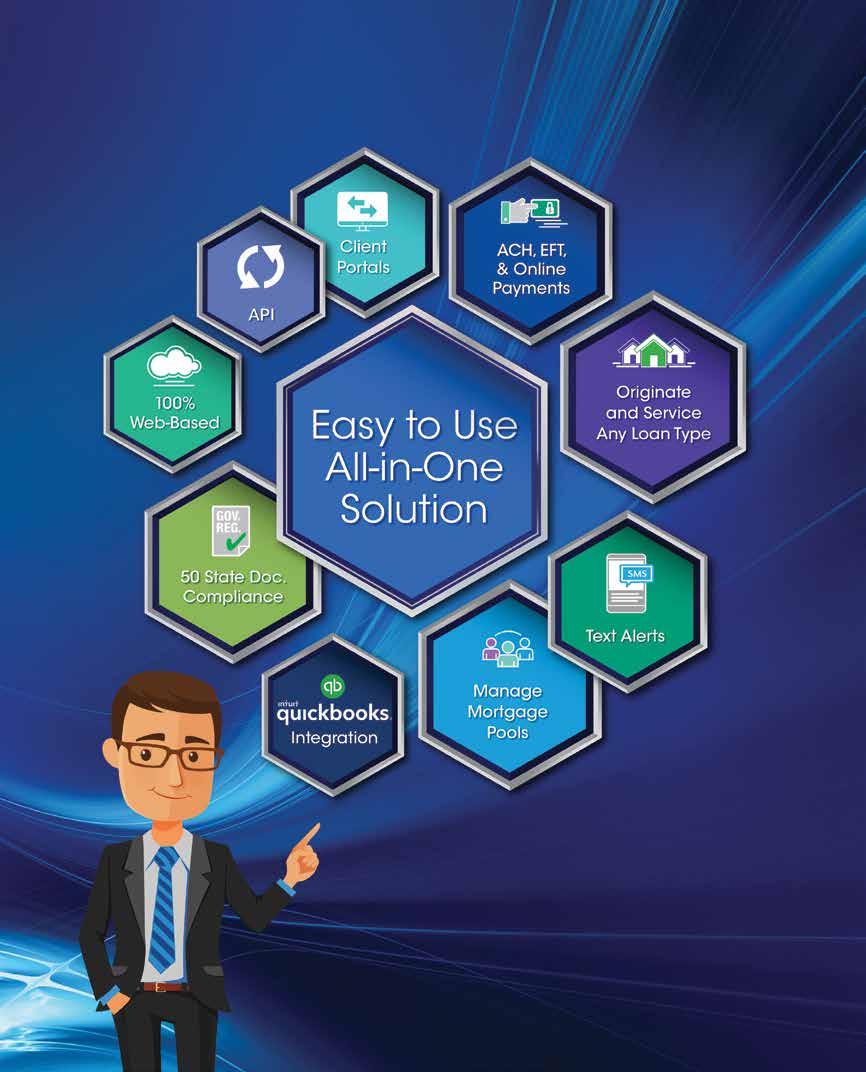
The Official Magazine of AAPL | Summer 2022 OPERATIONS BPOs vs. Full Appraisals Page 16 MARKET TRENDS More Foreclosures on the Horizon? Page 70 LENDER LIMELIGHT Paul Jackson Lessons from a Lifetime in Real Estate ADVOCACY Anti-Money Laundering Laws Page 76





SUMMER 2022 3 06 ETHICS The Noncompete Dilemma 12 OPERATIONS 12 D igging Into New Construction Financing 16 Broker Price Opinions: A Viable Alternative to Appraisals 20 Wire Fraud in Real Estate Transactions 26 Foreclosure Pitfalls and How to Avoid Them 30 STRATEGY 30 Capital Partnerships: Are They for You? 34 Expanding into New Markets 40 FUNDAMENTALS 6 Ways to Push and Pull Loan Levers to Mitigate Risk CONTENTS SUMMER 2022 46 PROFESSIONAL DEVELPOMENT What Led a Conventional Mortgage Loan Officer to Work Exclusively with Real Estate Investors 50 LENDER LIMELIGHT Lessons from a Lifetime in Real Estate with Paul Jackson 56 TECHNOLOGY Automation 101 For Private Lenders 62 CASE STUDY 62 Rehab of Shotgun-Style Home Hits the Mark 66 Florida Condo Deal Built Long-Term Strategic Partnerships 16 70 MARKET TRENDS More Foreclosures Ahead 76 ADVOCACY Anti-Money Laundering Laws and the Private Lending Industry 84 MARKETING & SALES 84 Digital Advertising and Social Media: Blueprint, Budget, & Bandwidth 92 Why Cause Marketing? 96 VENDOR GUIDE 98 LAST CALL Tomorrow Isn’t Promised 70 76
4 PRIVATE LENDER CORRESPONDENT LENDING PROGRAM RCN Capital, LLC is licensed as a California Finance Lender under Department of Business Oversight license number 60DBO-46258. Arizona Mortgage Banker License BK-0932325. Oregon Mortgage Lending License: ML-5571; NMLS Company ID: 1045656. Contact Tiffany Walker, Manager of Wholesale Lending TWalker@RCNCapital.com 860.783.8844 Focus on Originating, With RCN As Your Guide Become An Approved Correspondent Lending Partner Today LEVERAGETOTAKE YOUR BUSINESSTONEWHEIGHTS J a w DroppingWhite-Labeled Origination ExpansiveNationwide Re a c h
EDDIE WILSON CEO, AAPL LINDA HYDE Managing Director, AAPL
KAT HUNGERFORD Executive Editor
 DAVID RODRIGUEZ Design
DAVID RODRIGUEZ Design
CONTRIBUTORS
Katie Bean
Daren Blomquist
Alex Breshears
Aaron Chapman
Michelle Esparza
Mark Filler
Abhi Golhar
Jesse Goldberg
Robert Greenberg
Tom Hajda Kellen Jones
Stephan Leccese
Rachel G. Packer
Kendra Rommel
John V. Santilli
Kim Slaughter
COVER PHOTOGRAPHY
Cai Chen
Private Lender is published quarterly by the American Association of Private Lenders (AAPL). AAPL is not responsible for opinions or information presented as fact by authors or advertisers.
SUBSCRIPTIONS
Visit aaplonline.com/subscribe.
BACK ISSUES
Visit aaplonline.com/magazine-archive, email PrivateLender@aaplonline.com, or call 913-888-1250.
For article reprints or permission to use Private Lender content including text, photos, illustrations, and logos: E-mail PrivateLender@aaplonline.com or call 913-888-1250. Use of Private Lender content without the express permission of the American Association of Private Lenders is prohibited.
www.aaplonline.com
Copyright © 2022 American Association of Private Lenders. All rights reserved.
FROM THE CORNER OFFICE
COMMUNICATING WITH BORROWERS AND INVESTORS IS KEY
In the past months, as inflation and interest rates have risen to further aggravate existing market pressures, the pandemic has shown it is not done with us yet.
As you add these variables into your “navigate this” list of low housing inventory, supply chain issues, foreclosure backlogs, and reticent capital sources, you may be feeling more than a bit hesitant about the path forward or, if not your path, then the timing of your journey and decision-making.
We have no guaranteed-accurate crystal balls to offer. However, as we lean into these challenges together as an industry, we’d like to remind you of guidance that has served our constituency well through the past few years of uncertainty:
Keep communication lines open with your borrowers and investors.
If capital suddenly dries up or loan payments stop arriving on schedule, it can be tempting to go radio silent with the impacted parties. Perhaps you fear that “anything you say can and will be used against you” will hold true in this arena as well. Maybe you’re hoping you can save the deal before the investor clues in, or that capital sources will sort themselves out before the borrower finds another lender.
The reasons for communication paralysis may seem myriad and justified, but we want to remind lenders that delayed communication can have a significant and painful impact on both your borrowers and your investors.
At the association, we have experienced a marked uptick in Code of Ethics complaints from borrowers who were in the middle of origination when all communication from the lender suddenly halted. In fact, that is the only kind of Code of Ethics complaint we have had this year. Universally, the borrowers felt strung along, with most having accrued significant hard costs from the delay. Many were unsure whether they were at a point in the transaction where finding a new lender would put them in legal trouble, and they were wary the next lender would force them into similar circumstances.
Recent months have spotlighted an issue that not even the early days of the pandemic brought out of the shadows: Prompt and direct communication is foundational to both individual businesses and the private lending industry’s reputation and viability.
We believe so firmly that responsible communication is key that we will be formally adopting specific verbiage to address it, although our Code of Ethics already indirectly governs the matter.
We must come together to nip this growing trend in the bud and correct the impression that silence is of any advantage. After all, the upheavals of the pandemic have already proved the rewards of maintaining open lines of communication: Lenders who transparently and professionally explained delays and other transaction-impacting issues earned client loyalty, alongside reputations for trustworthiness and leadership.
LINDA HYDE Managing
Director, American Association of Private Lenders

SUMMER 2022 5
ETHICS
THE NONCOMPETE DILEMMA

As is the case in most ethical scenarios, intent, communication, and action are key.
by Kellen Jones
6 PRIVATE LENDER
Employee turnover can be costly and disruptive. To mitigate their risk when employees leave and to protect intellectual property and trade secrets, some companies require certain employees to sign noncompete agreements. However, some of these agreements fail because they are overly broad in trying to keep workers from freely moving to other organizations.
In a marriage, a prenuptial agreement can provide either great clarity or create
contention when one spouse chooses to leave. In a professional setting, establishing an ethical standard for post-employment takes effort from both employers and employees. Let’s consider the case for noncompetes and the viewpoint of each party.

THE ENVIRONMENT OF NONCOMPETES
of them before accepting a new employment arrangement, and they learn others using the resources of the new company. Although most companies likely support personal growth and encourage ambition, many companies find it difficult to balance that with talent retention. Some companies try to incentivize retention and loyalty through upward mobility and higher compensation, and others may establish roadblocks to keep a professional from moving on and thriving in another work environment.
The central issue is employers want to ensure the time and money they invest in new hires pays dividends. And, if the arrangement turns out not to be a good fit, employers want to know that any proprietary data the employee had access to gets restricted or destroyed. Most important, companies want to make sure its trade secrets aren’t used against them or shared with a competitor.
Historically, companies have worked to establish legal boundaries for their data and other sensitive information. Enforceability has become increasingly difficult, because the view on noncompete agreements has trended in an employee-friendly direction. With more and more hostility toward noncompetes and with less likelihood a company will prevail in the event of litigation, how can companies protect themselves? What are the best practices for members of AAPL? What part does the community play?
The private lending community is full of diverse skillsets. Employees learn some
New regulation may eliminate some of the historical strategies employers have used and misused. For decades, noncompete covenants and agreements
SUMMER 2022 7
ETHICS
have provided a standard defense for companies wishing to protect their data when an employee leaves. But use of the tool has dramatically decreased over time.
In July 2021, President Biden charged the Federal Trade Commission with determining how noncompetes can be eliminated or restricted nationally and replaced with mandates on how companies control stored and shared information. Illinois, Maine, Maryland, New Hampshire, New York, Rhode Island, Virginia, and Washington, D.C., have introduced new state laws in the last five years for low-wage earners, and other states have been more aggressive with noncompete alternatives.
THE EMPLOYER’S PERSPECTIVE
Businesses work hard to establish a brand and a product or service consumers will demand—and it’s not uncommon for founders to expend significant money and time creating them. Confidential information is created and articulated in business plans and projections. Pricing structures and sales strategies are established. Training materials are published. It is not only ethical for businesses to protect these investments, it’s necessary for sustaining the business. Companies today have greater concerns about how freely and quickly infor-
mation can be shared in the market. The debate often arises around how to protect these properties and data.
Who owns what? If a loan originator is independently licensed and closes a loan with company resources, whose lead is it?

If a company sponsors an event or conference at which a team member collects business cards and creates relationships, but then the employee leaves the organization, what are the rules of engagement with those contacts moving forward?
If a team member learns how to successfully complete projects with company resources, is it appropriate for the employee to independently identify how to do the
8 PRIVATE LENDER
same thing, while still employed? What about when they leave the organization?
What if a new employee signs with a company without disclosing their intention for the position is temporary? With remote work, a member of the team could technically hold more than one position at time, even at competing organizations. What should be disclosed?
If a competitor approaches a gainfully employed member of another organization with an offer, what should the ramifications be, if any, for the competitor or the team member? And are those ramifications enforceable?
These are just some of the circumstances companies try to avoid by implementing a noncompete or confidentiality agreement. It’s important to note that noncompete agreements can be both ethical and binding.

THE EMPLOYEE’S PERSPECTIVE
Noncompete agreements create challenges and disadvantages for employees. They may restrict upward or lateral mobility, within or outside a company. They may restrict an employee to a certain field or position for an extended period of time. They can also be outright abused, even when employers maintain full autonomy to layoff or fire anyone, for any reason, at any time.
Noncompetes can lower the market value of a skilled employees merely exercising their right to change careers or organizations. Some employers have earned a reputation for litigating against former employees, even after terminating or laying them off.
SUMMER 2022 9
“Separations should always be amicable between professionals and high-functioning organizations.”
ETHICS
What if an employee signs a noncompete and then the market forces the company to layoff much of its work force?
What if an employee signs a noncompete but doesn’t actually gain any access to the property or relationships the employer is trying to protect?
Employers should understand that human capital comes with human emotion, and sometimes people just need a change. A departure isn’t always rooted in a negative reason. Employers may have a natural curiosity about the reason behind someone’s decision to leave an organization, especially when the relationship between the parties was amicable. Sometimes that curiosity comes from a place of support for wherever the employee lands next, and sometimes it’s to ensure that more discussion doesn’t need to occur about the company’s data and property.
Even when the departing employee is moving to a competitor’s organization, if the company did things appropriately, there should be little to no fear about the employee’s next move.
ETHICAL ANSWERS
Until laws around noncompetes and employee confidentiality evolve, adhere to local counsel before implementing or unwinding any major policy. If you’re employed, know your rights. The following suggestions may protect an employer’s trade secrets while providing employees with their right to explore and secure a better-paying position or one that is more aligned with their skills or career goals: Before accepting a position (and then again if an employee is considering
other employment), communicate needs and expectations with the employer to ensure they know what is expected so you can grow with the company.
Establish policies and procedures for the organization that define what the company refers to as proprietary, who can access and share it, and with whom.
Enter into employment agreements or contracts that define each party’s role, where both can agree on what is deemed sensitive and preexistent, as well as what each party is permitted to retain in the event of termination of the relationship.
Implement security protocols and role-based access so parties are allowed access only to what is needed to accomplish tasks at hand.
Be clear about who owns what data— and even equipment—so all ambiguity is removed (i.e., if an employee uses their own computer, phone, and lending license, then leaves an organization, what protocols are taken to unwind the relationship while allowing the party to maintain their equipment).
Establish clear employee onboarding and off-boarding procedures and task someone with the management and consistency of the processes.
As is the case in most ethical scenarios, intent, communication, and action are key. Employees and employers must strive to remove doubt and make expectations clear. Organizations should foster a culture where employees desire to stay as long as they’re valued and growing.
When they choose to move on, perhaps they first attempt to reconcile differences
or find an appropriate role or structure internally before moving to a new organization. And if a relationship does end, beyond the establishment of the policies and procedures outlined above, separations should always be amicable between professionals and high-functioning organizations. ∞
ABOUT THE AUTHOR
KELLEN JONES
Kellen Jones is president and co-fund manager at Prospera and CEO of Funding Database. Over the last 15 years, his companies have originated over $1 billion in volume. Beyond the private lending activity within Diversified Fund, Jones co-founded Prospera Growth Fund in 2017, which now exceeds $300 million in value. The group also manages two property‑specific opportunity zone funds.
Jones has become a thought leader with an emphasis on underwriting and credit quality, capital raising and management, and business ethics. Jones serves on AAPL's Ethics Committee and advises businesses in several verticals from fintech to retail.

10 PRIVATE LENDER
Filmed on location, Titan Talk is a one-on-one interview between you and Eddie Wilson, CEO of Think Realty and the American Association of Private Lenders. This personal endorsement carries extensive publicity, marketing opportunities, and bragging rights, naming you as the exclusive
Titan of your real estate sector for a year.
What’s Included
• A One-on-one, 20-minute video interview by Eddie Wilson filmed on location, with B-roll footage of your office shot for use in the video.
• A featured article in Think Realty Magazine and Private Lender magazine, with the article publicized as a preview line item on the magazine cover and highlighted in the corresponding newsletter.
• A Titan Talk web page dedicated to you as the exclusive Titan of your real estate sector for 12 months. The page will headline your video interview, profile, featured article, and other articles by you.

• Your video interview posted on Eddie Wilson’s personal social media pages and website.
• Your video interview posted on the Think Realty Podcast page.
CONTACT
SALES@THINKREALTY.COM FOR

• Six social media posts on Think Realty and AAPL’s Facebook and LinkedIn pages.
• Presidents’ Circle membership for one year.
Brought to you by: MORE INFO!
Digging Into New Construction Financing
by Jesse Goldberg
New residential development has become a natural part of the trajectory for investors who start with renovation and graduate to a more advanced understanding of the construction and rebuild processes . As existing inventory continues to diminish, and profit becomes slimmer on flips, knowledgeable investors across the United States are seeking out tear- down and vacant land opportunities.
To accommodate these investors, business purpose lenders are following suit by offering construction financing, either as an extension of their rehab programs or as a new loan product. But when taking on this financing risk, just exactly what should a lender take into consideration?
Although the risks inherent in construction lending may be perceived as greater than the risks of a traditional flip, in many ways, new development is often a more straightforward process.
As you evaluate how you would like to start lending on new construction loans, here are the key factors to take into consideration.
LAND RISK
It’s important to decide how much land exposure you want during the loan’s term. The lowest land exposure risk exists with developed infill lots and tear-down projects. The 2020 Annual Builder Practices Survey (ABPS) showed that 25% of new detached single-family residences across the U.S. were infill lots or tear-downs.
Infill lots are commonly defined by their location in a developed neighborhood or city surrounded by similar asset types. These plots of land typically require few or no horizontal improvements (e.g., digging trenches for utilities or heavy grading) before they’re ready to “go vertical” or the foundation work begins.
The land risk for both developed lots and tear downs can be mitigated by setting clear underwriting guidelines that detail what is acceptable for your company. Requiring permits prior to your loan’s closing date, especially on tear downs that can have permits and plans trailing, helps reduce scope-of-work changes after close. As construction continues at the property and major milestones are completed (e.g., framing), your loan-to-value will slowly decrease as the value of the asset increases.
LOAN LENGTH
The length of the loan is a key decision you must make. Your decision depends on whether your firm balance sheets your loans or may sell them during servicing.
Construction timelines can vary wildly, depending on the type of project (e.g., undeveloped land, developed land, tear
12 PRIVATE LENDER OPERATIONS
As you evaluate how you would like to craft new construction loans, consider these key factors to take you from land acquisition to completion.
downs, mid-construction, multi-lot development, etc.), but you should always request a clear timeline for milestones, preferably on a construction schedule.
Most residential 1-4 units can be completed, and loans exited, in the 12- to 24-month terms commonly offered by bridge lenders. Always communicate clearly with the borrower about their
expectations of the timeline and adjust the loan terms accordingly.
EXTENSIONS
In the wake of the pandemic, it became more important to investors to have extension options for natural disasters and other circumstances outside their control.

Major MSAs across the U.S. have seen a backlog of permit submissions that have pushed entitlement and zoning approvals back by weeks, and even months, in 2022. In addition, rising gas prices and difficulty with material procurement have resulted in construction project delays.
As you think about your construction products, consider extension terms and
SUMMER 2022 13
language that allow the developer to complete the project if they have progressed normally outside of these delays.
ASSET TYPES
The next step is deciding which assets you’re going to start with. Depending on your market(s), you may find that density is a driving factor for new construction and, therefore, choose small or large multifamily projects. If you plan to focus on a product you can combine into a future DSCR product, 1-4 unit residential could be your niche at launch. You can expand your product and add complexity (e.g., lot-splits and subdivision loans) as your organization becomes more comfortable in this space.
EXECUTION STRATEGIES
The goal for a construction loan is to ensure the borrower can successfully complete the project and exit your loan. Once the borrower has received a certificate of occupancy, the most popular strategies are to either place the property on market or keep it for a rental. You should review a market sale loan to ensure that absorption of the type and size of the property is satisfactory and fits in the market. For properties that will be retained as rentals, you can either underwrite them to the asset resale or to an adequate debt service coverage ratio on exit.
QUALIFICATION CRITERIA
You will also need to decide who your product is for; in other words, set the qualification criteria.
Experience is a key factor you should consider in your qualification process. Working with a borrower (and/or their general contractor) who has experience in the asset class and type of construction the project calls for can be the difference between a project completed successfully within budget and a project riddled with delays and budget increases.
LIQUIDITY RESERVES
The amount of funds your borrower has available verifies your borrower’s ability to reach major construction milestones before a draw is provided. Consider how your construction draw management will work, and set expectations in your guidelines accordingly. For instance, if your company provided only draws in arrears, you may want to consider having the borrower show 20%-25% of the construction budget in liquidity to ensure subcontractors get paid before the draw submission.
MINIMIZING RISK
Unlike rehab projects, most states require a general contractor’s license to build a new home. It’s an important step to ensure your team, or a third-party construction loan administrator, understands the limits you place in your underwriting box and where your tolerances for exceptions stand. Conducting background checks, permit lookups, general contractor license searches, and reviews of previous projects the contracted GC group has completed are all ways to minimize risk on the project.
As land becomes scarcer and developers continue to expand into newer
developable areas on the fringes of MSAs, you can add new products to increase your reach to these investors. As your team gets more comfortable with 1-4 residential, expansion into multi-lot development and more complex residential projects become easier to embrace.
By developing products that follow the trajectory of your repeat clients’ business, you not only help retain the investor, but create a path for new and more experienced individuals to work with your company. ∞
ABOUT THE AUTHOR
JESSE GOLDBERG
Jesse Goldberg is the director of ground up construction for Civic Financial Services, responsible for the launch and ongoing development of the construction program. Prior to joining Civic, Goldberg was vice president of sales for a Goldman Sachs-owned private money lender, focusing on construction lending. He was also president and founder of a successful family-run private money lender that focused on construction, commercial, and bridge lending across the United States.

14 PRIVATE LENDER
OPERATIONS
Experience what Think Realty Conference & Expos have to offer

Network with professionals in our packed vendor hall and at the Cocktail Reception. Meet exhibitors specializing in REI tools, products, and services.
Attend sessions and specialty workshops on a variety of investment strategies. Access deal-making opportunities with the biggest names in the business.
Sign up for a FREE account for 20% off tickets. Register at ThinkRealty.com/TR-events.
BUILD WEALTH IN ANY REAL
ESTATE CYCLE TAMPA JULY 21 - 22
Broker Price Opinions: A Viable Alternative to Appraisals
by John V. Santilli
The appraiser logjam is an aggravating industrywide problem lenders have been forced to accept as immutable reality. The previous standard of 30 days to close a loan now averages closer to 45 days—and up to 90 days in more remote areas. The cost of an appraisal, which just a few years ago was $375, now averages more than $600, and it can run up to $2,000 for more remote housing or loans with speed-sensitive deadlines, according to a Dec. 6, 2021, article in Appraisal Buzz called “How Tech is Working on the Solution to the Appraiser Shortage.”
The reasons for the logjam are manifold. Even before the pandemic, a labor shortage in the appraiser space has meant slower wait times. Then, like everyone else, appraisers have been affected by COVID outbreaks,
and many have since left the field as part of the Great Resignation phenomenon. In fact, according to the Appraisal Institute, more than 10,000 appraisers have left their jobs since 2013, plus more than half in the industry are approaching retirement age. Add to that the sheer volume of real estate deals over the past two years and the causes for the backlog become clear.
In the past, appraisal management companies (AMCs) were a great resource for finding, staffing up, and hiring or subcontracting appraisers. However, they are being affected by the same volume of work and slowdowns.
Lenders are likely losing anywhere from 15%-30% of their business opportunities over speed-to-closing issues, which is not a sustainable situation, for home sellers, lenders, or borrowers.
For anyone buying a home, and especially for real estate investors, the wait time for an appraisal is simply not manageable. So many individual investors are now competing against major conglomerates and cash buyers that many properties will be lost in that window. As a result, many are turning toward closing without appraisals, a high-risk practice that any lender with a sustainability goal would not recommend.
MOVING AWAY FROM THE TRADITIONAL APPRAISAL
One possible solution for this crisis is the wider adoption of Broker Price Opinions (BPOs). As a faster, cheaper alternative to a standard appraisal, a BPO is typically conducted by a real estate agent or another real estate
16 PRIVATE LENDER
An industry-wide shortage of appraisers is prompting new approaches to asset valuation.
OPERATIONS
professional local to the neighborhood who has a handle on that market.
In lieu of an interior home inspection, BPOs rely on MLS and other accumulated market data to support an opinion of value. The majority of BPOs are based on comparative sold homes of similar style, room and bathroom count, along with square footage. In addition, with new technology tools, a BPO will allow lenders to value the property.
The BPO is just another resource for the lender to use for collateral valuation.
As with any resource, the key here is to ensure you are engaging an expert in the local real estate market. Larger financial institutions such as national banks, credit unions, and community banks use the BPO product when underwriting certain types of real estate loans.
Underwriting loans to the individual rather than the property is typically not done in asset-based lending.
But when leveraging experience, cash, credit, and cashflow to qualify customers, the BPO option becomes
only one piece of the puzzle—along with an inspection and a clear title.
A BPO allows lenders to accommodate a borrower's time demands, shorten the number of days to closing, and ensure the borrowers will be able to purchase the desired property. Now you can get a BPO within four days and be ready to close the loan in a week or two at most. That means the buyer can jump in, start renovations, and yield profits sooner. In circumstances where there are no recent interior photos, lenders opting

to use a BPO should also require a budget inspection to confirm repairs needed and obtain the necessary photos. Together, the BPO, repair statement, and photos help support the current condition of the property and give lenders a perspective on which to make decisions. As a customer service solution, BPOs allow lenders to better address customer needs and help customers reach their investing goals, which in turn ensures a strong ongoing partnership.
NOT A ONE-SIZEFITS-ALL SOLUTION
It’s important to note that BPOs are not a new service. They have been around for at least three decades, most often for people deciding whether to refinance, to determine a listing price for a home, or to facilitate a foreclosure or short sale. However, some state laws prohibit the use of BPOs in some scenarios or may prohibit the individual conducting the BPO from charging or receiving a fee for the service.
BEST PRACTICES FOR BPOS
Investors and lenders should always look closely at a BPO report to ensure it includes property type, property condition, market conditions, sale prices of similar properties, and a final value supported by all the above. Look closely at the distance of comparables to the property in question. Make sure the cited comparables are similar, and double-check the value against the property history to see if it seems realistic and reasonable.
A BPO can guide the market value, but again, it’s not the same as an appraisal. It cannot be used as a be-all, end-all number. It is, however, a quicker stopgap solution until the current appraisal crisis—and all its consequences for the real estate market—abates. ∞
An appraiser takes historic real estate trends and data into account—a bigger picture of the market, if you will. If you are not taking a personalized approach to underwriting, you may be opening your company to financial risk with this less official valuation.
Offering BPOs will not work for every lender and every customer. Almost certainly, the BPO will be more subjective and qualitative than an appraiser’s report. Obviously, the person conducting a BPO does not have the same skillset, training, and professional certification of an official appraiser. One risk is the person could have a conflict of interest or other reason their opinion might not be impartial. Red flags to look for are listing or selling agents affiliated with the same company that employs the person conducting the BPO, or a BPO supplied by the borrower.
If you are going to adopt BPOs as part of your qualification process, be sure to carefully vet the candidate who will be conducting them. Going through an AMC eliminates internal bias, and many brokers and real estate professionals are already connected to AMCs to offer BPO services.
An AMC will have already done the vetting work because they require a license, resume, and errors and omissions insurance.
Make sure you include a home inspection in conjunction with the BPO. Another resource that can support the BPO is a report from an appraisal validation company, which can be an added layer of due diligence on the valuation determination. Several well-known companies that, in addition to valuation services, will also review the validity of third-party appraisals are Clear Capital, Situs, and Protek.
ABOUT THE AUTHOR
JOHN V. SANTILLI
John V. Santilli is chief revenue officer of Rehab Financial Group. He joined RFG in July 2019 and manages all opportunities connected to the growth of the company. Santilli focuses on expanding the company’s sales channels to maintain RFG’s position as a leader in rehab financing.
Before joining RFG, Santilli had 25 years of lending and marketing executive leadership experience across multiple private and public marketing-dependent companies.

18 PRIVATE LENDER OPERATIONS
“AS A CUSTOMER SERVICE SOLUTION, BPOS ALLOW LENDERS TO BETTER ADDRESS CUSTOMER NEEDS AND HELP CUSTOMERS REACH THEIR INVESTING GOALS…”




SUMMER 2022 19
Wire Fraud in Real Estate Transactions
Stay alert to these red flags in the titling and settlement process to protect yourself and your clients from fraud.
 by Michelle Esparza
by Michelle Esparza
20 PRIVATE LENDER OPERATIONS
According to the latest FBI Internet Crime Compliant Center’s report, in 2021, losses from cybercrime in the real estate/ rental category reached $350,328,166. The total amount of losses reported for internet crime was $6.9 billion!
One place where real estate fraud can occur is during the title/settlement process. “Good Morning America” recently covered this topic to discuss how big this has become. The piece was titled “New warning about rise in home-buying scams.”
Wire transfer fraud is a major issue, and the internet has played a crucial role. In this type of fraud, the fraudster intercepts outgoing or incoming wires to a different account and, in many cases,
bank accounts in different countries.
You have seen the news stories about fraudsters acting as real estate agents, lenders, title companies, and even borrowers and sellers. During a legitimate transaction, the fraudster “takes over” the identity of one of these legitimate nonfraudster parties and provides bad wire information by changing wire instructions (usually at the last minute) that redirect the funds elsewhere.
These fraudsters typically hack someone’s email and watch communications between the parties. Then they wait until the time of the closing and make their move. For example, they pretend to be the title company and use a forged/hacked email that looks legitimate. The fraudster comes up with a reason about why wiring instructions need
to be changed. The buyer doesn’t verify this information with the person they have been working with and follows the new instructions, sending the money to the fraudster. In a flash, the money is gone. Time is of the essence to report missing funds, but in many cases, the fraud is not noticed immediately and the money is gone.
With today’s technology, fraudsters can obtain access to emails, hijack company logos and signature lines, and even set up phone numbers using a person’s name—all in an effort to sound legitimate. They go to great lengths to deceive you. Many work in large gangs, both domestically and internationally.
Phishing fraud occurs when a fraudster uses email, text, phone calls, or other methods to try to obtain banking details. This type of fraud often overlaps with other types of fraud like wire fraud.
PREVENTATIVE MEASURES
As fraud becomes more prevalent, here are some things you can do to help yourself and your clients.
Use a secure platform. Make sure you or your title and settlement partner use one of the several secured wire platforms that are available. These provide client wire information to the settlement company through a secure portal that is connected to most U.S. banks. These digital identity and device verification services are used by title companies, law firms, lenders, realtors, and homebuyers and sellers to prevent wire fraud. The technology uses enhanced features to verify the account holder matches the bank account

SUMMER 2022 21
information. Most come with large direct insurance coverage for your transactions.


Confirm wire instructions with your clients. Be sure to confirm wire instructions with your clients by phone, not email! Many victims of wire fraud have been compromised through email. Educate clients that if they are notified by email that something has “changed” right before closing, it can be a red flag. Advise them to call the person (the closer) they have been working with to verify the details.
Instruct your clients to be alert to the use of odd or slightly misspelled words in any emails they receive. For instance, “Miche11e” may be spelled with the number 1 instead of the letter “l.”
Remind clients to check emails and their URL addresses. It can be hard to spot discrepancies on mobile phone screens. Although mobile phones are convenient, the screen sizes are small, making it possible to miss something that would have been spotted on a laptop or computer screen.
Verify the wiring process with your vendors. Be sure you and your client know what the proper process is. Always be sure to call first and verify the process. Let your borrower know when they should expect funds to be received in their account and that you (or the title company) will call when the wire has been initiated. Conversely, if a borrower is wiring a down
payment, you—as the lender—should be in contact to confirm these details and educate the borrower on why they are necessary, because the borrower is unlikely to know best practices in this area. Share with current and potential clients that a lender will never request or send wire information by email due to the risk of the account being hacked or compromised. Any such request or sending of information by email is likely a scam.
Make sure you always ask for and receive your Federal Wire Reference Number. This reference number is a unique identifier assigned to the federal government through the financial institution that can be used to tract and investigate
22 PRIVATE LENDER OPERATIONS
O V E R 2 0 , 0 0 0 L O A N S F U N D E D T O D A T E M U L T I P L E L E N D I N G P R O D U C T S C O N S I S T E N T A N D R E L I A B L E D E L I V E R Y P R O C E S S C O M P E T I T I V E B U Y R A T E S R E S I D E N T I A L ( 1 - 4 U N I T ) , M U L T I F A M I L Y ( 5 + ) & M I X E D - U S E P R O P E R T I E S CLOSED LOAN PRODUCTS WE BUY INCLUDE: Bridge Residential & Multifamily Ground Up Construction Long Term Rental (DSCR/SFR) Balance: up to $5M (1-4 units) / up to $10M (5+) Up to 75% LTV/LTC Term: Up to 24 months Balance: $50K to $5M Up to 85% LTV/LTC Term: 30 years Balance: $50K to $10M Up to 90% LTV/LTC, up to 100% Budget Funded Term: Up to 36 months 1 5 M a p l e S t S u m m i t N J 0 7 9 0 1 2 1 2 3 9 3 4 1 0 0 w w w t o o r a k c a p i t a l c o m W E P R O V I D E I N S T I T U T I O N A L C A P I T A L F O R L E N D E R S N A T I O N W I D E W E B U Y T H E L O A N ; Y O U K E E P T H E C U S T O M E R T O O R A K C A P I T A L P A R T N E R S I S A R E A L E S T A T E D E B T I N V E S T O R B A C K E D B Y K K R & C O . T H E F I R M , W H I C H B U Y S R E A L E S T A T E L O A N S I N T H E U S A N D U K , H A S F U N D E D O V E R $ 7 B I L L I O N L O A N S O N R E S I D E N T I A L , M U L T I F A M I L Y , A N D M I X E D - U S E P R O P E R T I E S T O D A T E . For more information about our current product offerings, email us at BD@toorakcapital.com
the wire from the initiating bank to the receiving bank. This number is critical should you need to trace a missing wire and help retrieve your funds. Remember, this number can be generated only by the federal government and when a wire is placed in the wire system.Your title and settlement provider can provide you with this number. When dealing with non-U.S. citizens/foreign nationals, many title and settlement companies may insist on having funds leave or be received by a bank located on U.S. soil. This request is not necessarily a red flag; however, have clients check with the settlement provider to see what, if any, specific procedure needs to be followed. This request may also be a requirement of the title underwriter.
Proactively communicate from the beginning of the transaction, so everyone understands each step of the process and there are no delays in closing as a result of misunderstandings.
If you or your client are victims of wire fraud, notify the bank immediately! The bank needs to know as soon as possible so they can attempt to recall the wire. This is also known as a SWIFT recall. They will need the Federal Wire

Reference Number. Also report the issue to the Federal Trade Commission at www.ReportFraud.ftc.gov and to the FBI Internet Crime Complaint Center at www.ic3.gov/Home/ComplaintChoice.
THE LOUDER, THE BETTER!
Wire fraud may seem like a shameful event, so sometimes we keep the story and the warnings to ourselves. We pretend it did not happen and live with the guilt of being a victim. Fraudsters know this and thrive on us keeping silent as they continue to prey on more innocent people. They make a career out of this.
If you or your client are victims of wire fraud, get your story out, listen to others, share their stories too, and learn from their mistakes. When it comes to money, do not be afraid to ask questions.
Tell your clients that if something feels odd, question it. In real estate transactions, there are many key players—realtors, loan officers, processors, escrow officers, settlement agents, title agents, etc.—that can answer questions.
The more we all talk about this subject, the more we make others aware of the red flags! ∞
ABOUT THE AUTHOR
MICHELLE ESPARZA
Michelle Esparza is senior vice president at Apex Closing Services LLC, title and escrow specialists. In this role, she ensures client experiences and expectations are met across the entire real estate transaction. She works to construct tailored solutions to fit client and prospect strategies.
Esparza has more than 28 years of experience in the title industry and has worked at a large national underwriter as well as a large national title agency that catered to investors. She has worked on projects from local single-site to multisite, multistate deals. She also speaks in front of large groups/associations on a multitude of real estate topics.
She has a bachelor’s degree in banking from Palo Alto College, a marketing certification from the American Management Association, a statistics certification from the University of Texas at El Paso, and mortgage banking from the Mortgage Bankers Association.

SUMMER 2022 23

needs subject matter experts to guide initiatives that will shape the
the private lending industry.
for our 2023-2024 Education, Ethics, and Government Relations Committees today. Visit aaplonline.com/committees for more information and to apply today.
AAPL
future of
Volunteer
GOVERNMENT RELATIONS COMMITTEE

ETHICS ADVISORY COMMITTEE
EDUCATION ADVISORY
A SPECIAL THANK YOU TO OUR 2021-2022 COMMITTEES! AAPL would not be where it is today without their dedication and expertise.
AMBROSE, ESQ., Ambrose Law Group
CABALLERO, ESQ., Caballero Lender Services CORT CHALFANT, Nexus Private Capital NEMA DAGHBANDAN, ESQ., Geraci LLP
FALLOT, MM Lending MARK FILLER, Rice Park Capital RUBEN IZGELOV, We Lend CHRIS RAGLAND, Ragland Realty
CHRISTOPHER
GEORGE
MIKE
ALEX BRESHEARS, Lend2Live Learning ELIZABETH HILLESTAD, Civic Financial Services BETH JOHNSON, Flynn Family Lending SAM KADDAH, Liquid Logics STEVE KUPTZ, Trinity Mortgage Fund ERICA LACENTRA, RCN Capital BEETA LECHA, Spiegel Accountancy Corp JEFF LEVIN, Specialty Lending Group
MARTORELLA, ESQ., Geraci LLP RANDY NEWMAN, Total Lender Solutions
COMMITTEE
MELISSA
MIKE HANNA, Investmark Mortgage KELLEN JONES, Prospera KEVIN KIM, ESQ., Geraci LLP SUSAN NAFTULIN, Rehab Financial Group KEMRA NORSWORTHY, Bull Funding KENDRA ROMMEL, FUTURES Financial JEFF SPIEGEL, Spiegel Accountancy Corp JEFFREY TESCH, RCN Capital
Foreclosure Pitfalls and How to Avoid Them
by Rachel G. Packer
In an ideal world, borrowers would never default, and lenders could avoid the time and expense of foreclosure. Of course, defaults do happen, and lenders often find themselves facing many of the same avoidable issues that stall, or even prevent, recovery.
During the last two years, new foreclosure filings and overall foreclosure activity significantly decreased from prepandemic levels. This change was not due to an actual decrease in defaults; it was a result of various pandemic-related government moratoria, state legislation, and new regulatory requirements. However, according to an Attom Data Solutions’ April 2022 report entitled “U.S. Foreclosure Activity Sets Post Pandemic Highs in First Quarter of 2022,” foreclosure filings during the first quarter of this year have increased significantly. There’s been a 39% increase over fourth quarter 2021, and a 132% increase over first quarter 2021.
With foreclosure activity finally resuming, lenders should (1) keep abreast of ever-changing legislation and procedural and regulatory requirements, which vary from state to state, and (2) review their documents and policies and revise them as necessary to prevent snags in future litigation.
BEWARE OF STATUTE OF LIMITATIONS ISSUES
One of the main hot-button issues in New York foreclosures over the last several years has been its six-year statute of limitations (SOL) to foreclose on a mortgage. New York courts have concluded that, upon the filing of a foreclosure complaint, the six-year SOL to foreclose begins to run on the entire debt.
Due to the often-lengthy period cases spend in mandatory settlement conferencing (for borrower-occupied residential property), and the significant
backlog in motions, it is not uncommon for a foreclosure case to remain pending in New York for more than six years. This delay in disposition could result in a lien loss to the lender if the SOL expired during the pendency of an action and that action is then dismissed.
As the case law currently stands in New York, once the SOL begins to run, only a lender’s “affirmative act of revocation” will be sufficient to revoke its election to accelerate the mortgage and restart the SOL period. Alternatively, a borrower’s actions may extend or reset the SOL period even after it has expired, but only under very limited circumstances, including a payment/partial payment or the borrower’s express written acknowledgment of the debt and promise to pay it.
Notably, last February, the New York Court of Appeals issued a decision in Freedom Mortgage Corp. v. Engel, holding that a lender’s voluntary discontinuance of its prior foreclosure action
26 PRIVATE LENDER OPERATIONS
The best lenders continually adapt to whirlwind market conditions, and stay a step ahead of ever-changing legislation.
qualifies as an “affirmative act of revocation.” Further, the Court of Appeals held that a notice of deacceleration is sufficient to revoke acceleration.
A new bill, which has now passed both the New York Senate and Assembly, amends various New York laws related to the rights of parties involved in foreclosure actions. And, it effectively eliminates a lender’s ability to extend, toll, or revive the SOL for a foreclosure action once the cause of action has accrued. The bill also eliminates the option of an express written acknowledgment of debt to revive the SOL, leaving only a borrower’s partial payment as an effective acknowledgment.
If the governor signs the bill into law as currently drafted, lenders will be left with extremely limited defenses to borrowers’ quiet title claims seeking discharge of a mortgage on SOL grounds, leaving their portfolios subject to substantial losses. New York is just one such example; many judicial foreclosure states have
faced and addressed similar SOL issues. Lenders should, therefore, be aware of certain common pitfalls in foreclosure actions and take steps to avoid or mitigate such issues to prevent losses.

CLOSE THE GAPS IN LOAN DOCUMENTS
Lenders should review the language of their standard loan documents to ensure substantive provisions like payment, default, acceleration, and notice are clear and unequivocal.
Default. Commercial and non-residential mortgage loans may provide for an
automatic event of default under certain conditions, without requiring notice to the borrower and an opportunity to cure. If the mortgage loan terms require service of a notice of default on the borrower, ensure the contents of the notice and the mailing requirements are consistent in both the note and the mortgage and they are written in simple terms that are easily carried out in case of default.
Acceleration and deacceleration. Just as the note and mortgage undoubtedly specify the actions a lender must take to accelerate a loan, so too should both documents detail the action a lender may take to revoke a prior acceleration.
SUMMER 2022 27
“Complacency leads to stagnation, which is probably the biggest threat to a lender’s bottom line.”
Receiver. With respect to any receiver of rents provision, the language should provide that a receiver be appointed upon commencement of an action rather than upon default.
Statute of limitations. To the extent possible, the note and mortgage should include language whereby the borrower expressly waives SOL as a defense to payment of the debt or performance of any obligations under the note and mortgage, or as a bar to the enforcement of the note or mortgage, or any action brought to enforce either document.
ORIGINATE AND SERVICE WITH CARE
Because a lender’s proofs in a foreclosure action are generally based on business records, all records must be meticulously prepared and retained so as to be admissible in court. The most common borrower defenses in foreclosure include challenging a lender’s standing to foreclose; service of required notices (both contractual and statutory); compliance with any other statutory prerequisites to foreclosure; the execution, validity, and/or recording of the loan documents; and whether a default occurred. Have written policies and procedures for underwriting, origination, and servicing of loans, including detailed procedures for the preparation, mailing, and documenting of notices. Mandate training in and compliance with all applicable written policies and procedures for each employee.
If revoking a prior acceleration, the loan history should clearly reflect the
revocation, and the amount due following the revocation should not include the accelerated loan balance. Maintain proof of mailing, and if applicable, proof of delivery, for any deacceleration notices sent to the borrower.
Always maintain a detailed electronic business record of the location of any original loan documents (especially the note) from origination on, including any transfer of possession and the identity/authority of any agent or custodian taking possession of the originals on the lender’s behalf.
LOSS MITIGATION AND STRICT COMPLIANCE
Some states, like New York, require an election of remedies whereby a lender must choose whether to sue on the note or foreclose on the mortgage lien (or other security), but the lender is prohibited from pursuing both. Most also require strict compliance with statutory prerequisites like preforeclosure notices. Given private lenders’ often close relationships with borrowers, many of whom are repeat borrowers, offering early and diverse loss mitigation options like repayment or forbearance plans and loan modifications can help prevent foreclosures and maintain relationships with borrowers.
The basics of lending will always remain the same, but the best lenders continually adapt to whirlwind market conditions and stay a step ahead of ever-changing legislation. After all, complacency leads to stagnation, which is probably the biggest threat to a lender’s bottom line. ∞
ABOUT THE AUTHOR
RACHEL PACKER
Rachel Packer is Axylyum’s chief legal officer. She is responsible for the litigation and operational direction of regulatory issues at both the state and the federal level. In addition, she handles the development and implementation of the company’s internal processes and compliance programs.

Packer’s legal career spans more than a decade, during which she led teams with extensive experience in residential mortgage lending, financial institutions, and state and federal litigation. Prior to joining Axylyum, Packer was a partner with a multistate litigation firm, where she represented large financial institutions, mortgage lenders, and servicers. She also represented securitized trusts and business entities in state and federal court in matters involving complex commercial litigation, consumer finance matters, and bankruptcy, both at the trial and appellate levels. Following law school, Packer completed a judicial clerkship with the Hon. David B. Katz in the Superior Court of New Jersey, Essex County.
Active in the legal community, Packer is a member of the New York City Bar Association and the Hispanic Bar Association of New Jersey. She is also a barrister of both Bankruptcy Inn of Court and the Brennan-Vanderbilt Inn of Court. Packer has been featured in such notable publications as Mortgage Daily and The New Jersey Law Journal, where she was awarded the 2019 New Leaders of the Law award.
28 PRIVATE LENDER
OPERATIONS
















Capital Partnerships: Are They for You?

If you are seeking capital to grow your private lending firm, keep these strategies in mind.
by Mark Filler
As the private lending industry starts to face headwinds, including higher interest rates, more small- and midsized lenders are focused on growing quickly to compete. They know their larger competitors are receiving a better price when they sell loans. The small- and midsized lenders understand the biggest firms have better financing, more stable and reliable loan buyers, economies of scale, and equity capital to aggressively invest in marketing and personnel.
Lenders’ strategies for growing fast include remaining independent, raising equity, or selling the business. Let’s look at each option.
REMAINING INDEPENDENT
If you stay independent, you have complete control. There are advantages to that. But will you be able to grow fast
30 PRIVATE LENDER STRATEGY
enough? Do you have enough capital? For example, can you triple your marketing budget and hire 15 people—and still have sufficient capital to close a lot more loans? Are you willing to risk your capital? It’s easier to spend someone else’s money than it is to spend your own. Do you have all the advantages, resources, and expertise you need? Do you have the right IT?
Consider these questions as you decide whether outside equity is right for you:
01 Can you fulfill a partner’s requirements? This includes monthly detailed financial and production reporting packages, board meetings (which generally take several days to prepare for), extensive risk analysis, and a detailed budget process.
02 Are you giving up more control than you are comfortable with? Will you be fine if your partner requires their approval on loans that don’t fit guidelines? Are you OK if your partner insists on approving major expenditures?
03 Are you OK giving up some of your vendor relationships, including loan buyers, warehouse lenders, inspection companies, IT providers, and CPAs? Your partner is likely to require you to use some of their relationships, especially if they offer lower prices or other benefits that your current vendors don’t.
Partners could expect you to attend daily or quarterly meetings. Some partners will allow you to approve your loans; some will require they approve loans that don’t fit guidelines or are more than
$1 million. Some partners will require all loan approvals go through them.
Likewise, a partner could require complete control over your expenditures, or they may be fine with giving you control—or a level anywhere between the two extremes. They could also say you can make purchasing decisions as long as you are within budget.
PURSUING OUTSIDE CAPITAL
If you consider bringing in outside capital, you need to choose between raising equity (for a portion of the business) or selling the whole company.
Considerations include how long and hard you want to work, whether you want to maximize your proceeds now or have greater upside in the future, and whether you think it’s a good or bad time to sell given the market cycle. Buyers likely will be less aggressive in terms of what they will pay for a private lender, but that prediction is worth what you are paying for it. Even if you decide to sell 100% now, deals can be structured so you retain a lot of incentives and benefits.
Whether you sell a portion of your company or all of it, you could choose a partner that invests capital but is not
in the private lending business. Or, you could partner with a firm that is in private lending. Most likely, partners that are not in private lending will be less involved in your business. Partners that are in private lending will be more involved.
Any partner you choose should bring experience and benefits, including economies of scale, better pricing, additional loan products, better financing, IT, relationships, and back-office support. This infrastructure allows you to spend more of your time growing your business.
If you decide to bring in a partner, consider these questions to determine the right partner for you:
01 How involved will the buyer be? How much control will I give up? How often do we meet? What type of financial and risk reporting is required?
02 Who approves the loans? Who approves the budget? How much capital and resources will they provide to grow the business? How much capital do they have? The latter is more important, given recent market volatility.
03 Who decides whether to hire or terminate employees? A partner could be very involved in personnel decisions, they could give you
SUMMER 2022 31
“If you consider bringing in outside capital, you need to choose between raising equity (for a portion of the business) or selling the whole company.”
STRATEGY
authority if you are within budget, or they could give you more control.
04 Do you have to sell loans to your partner? What percentage? This could range from zero to 100%. Is their primary focus buying loans, or are they focused on investing equity and resources to grow your business? If your priority is growing and maximizing the business, and your partner’s priority is buying loans, you may not be aligned. Alignment is important.
05 Does the partner give you the actual price they receive on loans, or do they keep a profit margin? Again, this is important. If you have to sell them loans, how are you guaranteed you will always have the best price and products? These types of arrangements require extensive negotiation and expertise.
06 What happens if your partner does not want some of your loans? Are you still allowed to originate them if you can sell them? Some partners will allow this; some won’t. Some will say you can close the loan only if you table fund it (use the loan buyer’s capital). Does the partner have attractive loan products you currently don’t have?
07 Does the partner have experience buying and operating similar companies? Both are important. A lot of firms have one or the other, but not both. If the partner has not bought a company, how do you know if your deal will work out?
08 What is the potential partner’s track record? How did they respond when COVID hit and during the recent spike in rates? Their performance during those challenging times
may indicate how they will react to future market disruptions.
09 Is there a good cultural fit? The key people need to spend time together to ask questions and visit each other’s offices. Importantly, they must talk about the values of each company to ensure everyone will enjoy working together. This is critical.
10 What is your risk going forward? Do you have to contribute capital going forward, or does the partner put all the money in?
11 How much upside do you have? Are your incentives completely aligned with those of your partner? Is your equity treated the same as their equity? Will your partner let you benefit when they sell the company at a higher price in the future? For example, if the partner sells the business for a high multiple of earnings, can you sell at the same price?
How will a buyer value my company? The answer is complex. Generally, buyers look at a multiple of your pretax earnings. Deals can range from 1-10 times net income. You may need to negotiate whether to use prior year or current year earnings to determine the price. If profit margins go down due to market conditions, most buyers will pay less. Most buyers also factor in a percentage of your origination volume. Buyers have paid anywhere from 2%-8% of annual origination volume. They may look at the price compared to your book value, which could bring down the price. Typically, sellers receive a substantial portion of the sale price after the sale, based on metrics the buyer and seller agree upon. Most likely, the metrics will include future profitability and, possibly, volume. Anywhere
from 20% - 80% of the total purchase price could be paid based on these metrics. That will be a major point in negotiations.
As mentioned, the earnings multiples buyers will pay varies. There is no simple formula, but keep the following in mind:
Larger companies sell for much higher multiples than small companies
Whether your business is “institutional”
Whether your volume comes from a large group of productive loan officers, or just a small number
Loan performance
Market timing How fast senior management can grow volume and profits ∞

ABOUT THE AUTHOR
MARK FILLER
Mark Filler is a partner at Rice Park Capital, a private equity firm that specializes in mortgage-related industries. One of Rice Park’s largest investments is in residential private lending. Their goal is to invest equity in or buy the best private lenders, to quickly become a large, nationwide lender. Filler has been in the mortgage business for 25 years. His companies acquired 30 mortgage lenders. He also founded a private lending company and sold it to Blackstone.
32 PRIVATE LENDER



EXPANDING INTO NEW MARKETS
by Stephan Leccese
The private credit market has seen steady growth since 2005. In 2005, private lending made up just 5% of the total U.S. credit market. In third quarter 2021, it was 30%—and there doesn’t seem to be an end in sight for that steady growth, according to an April 2022 report entitled “Private Credit’s Rapid Growth: A Secular Trend” from Blackstone Securities Partners L.P. There are many reasons for that growth, but they point to a healthy economy and strong asset classes across the board.
On a practical level, the growth of private lending means greater competition for private lenders in the market, but it also means increased opportunities for those lenders.

34 PRIVATE LENDER
Consider this four-step process before making any final expansion decisions.
STRATEGY
One of the best ways to increase profits and revenues is to expand into new markets.
Let the following be your guide to successfully expanding your lending business.











WHEN IS THE RIGHT TIME TO EXPAND?
To make the most of your expansion efforts, the first question any lender should ask is, “Should I, or should I not, expand?” The standard answer is always, “It depends.”
Every lending business is different. Even private lenders within the same sector and geographic region may have completely different approaches to credit, different
business philosophies, and different values. Whether it’s right for your business to expand into new markets, and when, depends on those differentiating factors.
First, what is the market outlook for your lending business? What’s the competition like in the market you have your eye on? What is the size of that lending market? What types of lenders service that market currently? You’ll need to do a complete market analysis to determine whether there is an expansion opportunity.

Next, what is the financial health of your business? Can you afford to expand? Will you have to borrow to expand?
Is your team capable of handling an expansion? Will you have to hire new
people? Could your current team handle an expansion without new hires?
Finally, what is your overall market position? If you’re at the top of the market in most of the areas you currently serve, you may benefit from an expansion into a new market. If you sit near the bottom of the market, would expanding into a new market benefit your business? You may be better off improving your operations so you can increase your market standing in the markets you’re already serving.
These are necessary questions to ask before you begin any new market expansion effort. Be sure to evaluate your company’s financial health thoroughly. Otherwise, you could find yourself in serious trouble.
SUMMER 2022 35
LIQUIDITY SOLUTIONS FOR PRIVATE LENDERS Fidelis Investors is a dedicated strategic capital partner for private money lenders throughout the United States. Our platform helps lenders, like you, raise capital by e ciently selling loans. Since 2009, the Residential Investment Team has successfully transacted in over $3.0 billion of whole loan purchases. Institutional Note Buyer Common Sense Purchase Guidelines Long Term Strategic Partner Fidelis Investors LLC 25 Commerce Dr, Suite 330 Cranford, NJ, 07016 info@fidelis-investors.com 908-402-8132 www.fidelis-investors.com
STRATEGY
THE BENEFITS OF EXPANDING INTO NEW MARKETS

Growth and risk are not necessarily related, but planning for each can help you better determine your expansion path and, most importantly, the timing of that expansion.
Sharestates based its decision to launch a national sales expansion on the company’s strong financial health and a critical analysis of market opportunities nationwide. Since 2013, the platform has grown quickly, but its loan origination footprint was entirely in the Northeast U.S. There was a lot of room for growth.
Following the pandemic, the lending market began to ramp up again. We asked ourselves, should we rebuild what we had before the pandemic, or should we attempt to broaden the reach and scale of the business? Sharestates chose the latter because it would have been riskier to maintain our current market position while the competition expanded into new markets. So, we leveraged the lessons of our past to expand into new growth opportunities.
The macroeconomic drivers of the private lending market overall supported that rationale. Market expansion is risky, but continuing to provide value to customers in new markets makes it a risk worth taking.
The decision to expand into new markets across the country was not predicated on growth alone. Post-COVID, building a company at scale requires a new way of thinking. Sharestates’ national expansion plans relied on the core internal capabilities of its team and a belief that the lender could improve value for shareholders.
On that note, there are five benefits to expanding into new markets:
01 Leads to long-term company growth
02 Provides access to new labor pools
03 Creates economies of scale that can increase loan originations more cost-efficiently
FOUR STEPS TO EXPANDING INTO NEW MARKETS
Expanding into new markets is both an opportunity and a risk. To mitigate your risks, craft a viable plan for your business. To leverage the best opportunities, be sure to assess your company’s strengths and weaknesses and conduct a thorough market analysis.
After conducting a thorough market analysis, if you decide expansion would be beneficial to your business, there are four steps you should take to ensure your expansion is successful.
Conduct an accurate assessment of your business.
Are you ready to expand based on the current health of your business? If not, then you may want to delay expansion until your business achieves a level of financial health to support it.
Assess the strengths and weaknesses of your company and your team. Are you currently capable of expanding into new markets? You may need to hire some key team members before you expand—and that’s OK. If so, you need to know that before you start the expansion.
Why are you expanding, and what do you hope to achieve? You should have a clear idea before you begin.
Your expansion plan must leverage your company’s strengths (brand

reputation, cost advantages, customer value proposition, etc.) and include contingencies around your weaknesses and biggest risks.
Other considerations include licensing requirements in the markets you want to expand into, lending limits, distance lending requirements, capital considerations (what will it cost to expand into each market?), differences in lending products expected by customers in the markets you want to expand into, and the length of your internal decision-making process.
Do a returns analysis. Understand your potential return on investment and the cost to achieve your goals. Be specific about the costs involved and outline clearly what success will look like. Run the calculation of a return against alternatives.
Set goals.
Develop your expansion plan focused on achieving your goals. It’s important to narrow your focus toward just one or two goals. Don’t think too broadly. Set targets you can accurately measure.
Execute.
Finally, make sure you have the team to execute your expansion plan. Whether you plan to expand nationally or into single markets, you should have any new key hires on staff before you execute
that expansion. That is critical to the success of your market expansion.
When it comes to determining capital requirements for expansion, break your analysis down by region. For example, if you’re planning to expand nationally and organize your sales team into five different regions, how much will it cost to expand into each region?
Align your expansion goals with the length of your decision-making process; otherwise, you may find you don’t have the time to ramp up your resources before your planned execution date. All expansion details must be laid out before you execute. ∞
ABOUT THE AUTHOR
Stephan Leccese is the chief operating officer for Sharestates, where he is responsible for strategy, operations, and driving growth initiatives for the company. Prior to Sharestates, Leccese launched and scaled the single-family residential whole loan buying operations for a leading technology-driven investment manager providing professionally managed portfolios of real estate loans. Previously, he was a co-founder of and scaled a technology-based direct lending and investment platform for single-family residential business purpose loans.
SUMMER 2022 37
04 Diversifies holdings through disparate market conditions
05 Makes a company more competitive
STEPHAN LECCESE

We now offer our signature Certified Private Lender Associate and Certified Fund Manager courses online, so you can earn your AAPL-backed certified status from the comfort of anywhere — and promote it everywhere. CPLA Modules • Intro to Business-Purpose Lending • Legal Documentation • Underwriting • Loan Servicing • Workouts CFM Modules • Intro to Securities • Pros, Cons, & Considerations • Structure • Creation & Launch • Administration AAPL Certifications are members-only. Enroll online at aaplonline.com/courses for $349.

6 Ways to Push and Pull Loan Levers to Mitigate Risk
Just don’t forget that moving one lever impacts the entire project you’re funding.
 by Alex Breshears
by Alex Breshears
40 PRIVATE LENDER FUNDAMENTALS
As a private lender, there are a lot of levers you can pull to mitigate risk, including changing terms to offset the risk of a loan.

Remember, risk tolerance is less about a number and more about how you feel sleeping at night knowing the loan is out there. But remember, when you change loan parameters, you need to consider how doing so might affect other areas of the project. Pulling one lever impacts other places. The trick is to figure out those second- and third-order effects and whether those effects are intended.
For example, adding a co-borrower requirement to a loan may help add more
capital on paper for the loan, but you may have introduced a risk of partners not getting along and finishing the project on time or on budget. If the original borrower and co-borrower haven’t discussed roles, responsibilities, and injection of capital into the project, the risk of default could actually be higher than if the borrower took on the project independently.
Another thing to consider is whether you are accurately assessing the risk level. One lender, still viewing their local market as red-hot, may continue to push LTV amounts, thinking their equity buffer only gets bigger with forced appreciation. Another lender may perceive the red-hot
market as getting “too bubbly” and back off. If both lenders are in the same market, how do you assess which one may be right? That is the million-dollar question! Here are six levers you can push or pull to mitigate the risk of a loan, depending on the loan situation and your risk tolerance with the loan.
LOAN TO VALUE
Loan to Value is the first lever many lenders pull back when uncertainty arises. Lowering the LTV means
SUMMER 2022 41
you have less capital at risk if the borrower fails to perform on the loan, whether that’s due to their own project miscalculations or a market correction.
Some lenders may assess lowering the LTV is safer because it builds the equity buffer. If 2008 taught us anything, we learned exactly how fast that buffer can disappear. The risk with moving this lever on borrowers who are currently in the pipeline for underwriting but haven’t closed yet is the the project then risks being underfunded, making it difficult to exit the loan.
If the property requires significant renovation and the borrower runs out of capital when the place is taken down to the studs, the value of that property
is automatically going to be worth a lot less. Again, if the project stalls out here, that equity buffer is likely negatively impacted. Lowering the LTV isn’t the failsafe many new lenders believe it to be, but assessing the impact the lower LTV makes to the loan scenario can help avoid potential pitfalls.
lenders believe the borrower is the person making decisions on behalf of the property. This belief may give lenders a false sense of security, causing them to fund atypical properties because of their faith in the borrower. Think tiny homes, container homes, or some other structure that is out of character with the surrounding area or made from unique building materials. Narrowing criteria for property could also look like avoiding rural properties, luxury residential housing, and second home properties and markets. These types of properties don’t tend to fair well in an economic downturn.
With the longer-term real estate market largely up in the air amid the hysteria of early 2020, some small lenders might have opted to fund projects needing minimal rehab so they could be placed back on the market and sold amid an epic housing shortage. In addition, major rehabs required laborers to be at the property, sometimes multiple teams at the same time, which meant social distancing requirements would significantly delay project timelines. As delays wore on, raw material prices rose quickly as supply and demand worked against each other. A borrower doing just a light rehab on a smaller home will be less affected by material prices than a major rehab project on a 4,000-square-foot property.
NARROWING CRITERIA FOR PROPERTY
Some small private lenders may spend a significant amount of time underwriting the borrower but take only a cursory look at the property details. These

CAPITAL RESERVES
During the pandemic, investors with sizable portfolios of rental properties lost income on those units because tenants were out of
42 PRIVATE LENDER
FUNDAMENTALS
work and programs for rent relief or direct payments to individuals were not up and running yet. As a result, many lenders— conventional and alternative lenders alike—started requiring capital reserves (proof of funds) to cover a specified number of mortgage payments, typically six months to a full year. Capital reserves could keep many investors afloat when rehab draws were halted or tenants stopped paying and, therefore, reduced overall risk for the lender.
Small lenders can use this lever if they feel the borrower needs a larger capital buffer, is inexperienced, or the project takes longer (and usually goes overbudget).
Liquid capital means the borrower has more options to make the payments,












fix overruns in rehab, and qualify for conventional financing if they are trying to refinance out into a longer-term loan.
Just as in the conventional lending space, a new capital reserves requirement may put a borrower out of the running for a loan. Rarely will you hear of a lender who regretted not funding a loan. There are plenty of opportunities out there, and smaller lenders may feel they need to compete with larger institutional lenders and offer more lenient terms. The opposite is true! Smaller lenders doing balance sheet loans often have flexibility larger companies lack. That doesn’t mean you should offer more lenient terms,
but you can move the levers you want according to each lending opportunity.











PERSONAL GUARANTEES
To be competitive, some lenders may not require a personal guarantee from a borrower. During the Great Resignation, some borrowers chose to live off reserves while looking for better employment opportunities.
If the loan requires a personal guarantee from a borrower, there need to be assets to back up that guarantee. The personal guarantee helps reduce the risk of not
SUMMER 2022 43
FUNDAMENTALS
being made whole at the end of the loan. A personal guarantee with a borrower who has next to no assets is basically worth about as much as the paper they signed on. Pulling this lever can also involve bringing on a co-borrower who will also sign a personal guarantee with assets to back up the ink on the page.
LENGTH OF LOAN CHANGES
Early in the pandemic, some smaller lenders changed the length of the loan. For example, many lenders offered longer loans, some 18-24 months in length, to allow for more time to deal with material shortages and social distancing for laborers and technicians. The idea was to allow the right amount of time for the project and borrower needs.
Lenders who chose projects with fewer renovation requirements may have had a shorter length of loan time, perhaps eight months with an ability to extend. Again, keep in mind that changing one metric has a ripple effect on other parts of the loan. Funding a loan for a project requiring significant renovations, but then requiring the borrower to complete the work in eight months is likely setting the borrower up for failure.
The other side to this discussion are the lenders who wanted that longer loan term for consistent cash flow from solid borrowers while the world established how to operate in this new normal. The downside of longer terms for loans is that a lender may not be able to spot a borrower who has a project running behind due to mismanagement.
LOWERING PROPERTY VALUATIONS
Markets may vary greatly, but if you think it’s a hot market how can you safeguard yourself? Getting a formalized opinion through a comparative market analysis, broker price opinion, or appraisal can offer an unbiased second opinion on value and takes the guesswork out of valuations.
A lender that chooses to perform self-valuations can limit comparable properties sale dates to the last 90 days only to get a better idea of more recent values. In cash flow markets, appreciation tends to be less, so having more conservative valuations in these markets specifically can help with maintaining an equity buffer.
Other things to avoid would be cashflow markets and focus on appreciation markets, which fair better in a down economy. Choosing to fund residential property near the median home price of your market can offer a quicker and easier exit typically. Condos also tend to slump as borrowers become hesitant to take on large fees that many condo associations charge owners.
Remember, these six levers don’t exist in a vacuum. Pulling one can cause unintended consequences downstream, introducing more risk to the lending opportunity than the original loan parameters. When you consider a potential change, ask yourself, “Why?”
What specifically are you trying to mitigate? Does the contemplated change truly address that risk?
Sometimes talking through the situation with another private lender can help you decide whether your solution is sound or could cause more problems than it is worth. There isn’t always a right answer. Sometimes there’s just the “best choice” given the information you have available combined with some educated guesses about the future. ∞
ABOUT THE AUTHOR
ALEX BRESHEARS
Alex Breshears is a private money lender, short-term rental owner and manager, LP investor in syndications, and private lending fund manager.
Breshears started a private lending company, Infinite Road Investments, in April 2020, funding first lien and second-lien positions for residential property in the Hampton Roads, Virginia area. She also started an educational Facebook group called “Private Lending Lessons” that offers weekly educational lessons, daily posts for discussion, and opportunities to network with other investors about private lending and projects that may need funding.
Breshears is also passionate about financial education and independence for female investors.
She is currently a chemistry professor, teaching for a four-year school.

44 PRIVATE LENDER

What Led a Conventional Mortgage Loan Officer to Work Exclusively with Real Estate Investors
by Aaron Chapman
Everyone has heard stories about a loan that went bad at the final hour. A familiar one centers on the buyer getting excited about a new home and going out and financing expensive new furniture, killing their debt-toincome ratio. Another involves the real estate investor who has worked hard to build a portfolio and decides to finance a brand-new luxury vehicle right before a closing, only to end up with the exact same situation: Their DTI ratio is blown out of the water, and they are unable to close.
My 24 years of experience is in the conventional lending space. I’ve seen many deals take a negative turn. Many of them would stand out as “I-never-want-to-dealwith-again" or "willing to work with as long as there is an understanding—and respect those boundaries."
Here are some actual situations I encountered as a conventional lender
that finally made me get honest with myself and decide to work only with real estate investors.
BEARING UNEXPECTED BAD NEWS
The first of the worst things I’ve experienced was surprising a person with very bad news they didn’t see coming.
At the end of every transaction, we are required to verify employment to ensure the borrower still has gainful employment. As part of the verification, we directly ask the employer whether the borrower is still employed in the same role they started with. On extremely rare occasions, we have been told the borrower was being let go, but our borrower had not been told yet. In those situations, we have been forced to decline the loan and explain why. Imagine having to hear that you were losing your job from your lender rather than your employer—and on the day you
are intending to close on the purchase of real estate.
NOTHING “PERSONAL”
Early in my career I was told you must be present for anything and everything—to always pick up your phone, and take every appointment for anybody and everybody to build your business.
Taking this advice to heart, I accepted a call and agreed to meet with an older gentleman and his son, who was in his mid-thirties. We met at my office on Christmas morning 1998 to discuss refinancing the home they occupied. The appointment went as it normally would. I then prepared the loan file and processed it through to closing.
At that point in my career, I was barely closing one to three transactions a month, so one transaction was a large percentage of my income. The day of closing came, and we did not receive the closing documents back for funding.
46 PRIVATE LENDER
The bottom line is all lenders — conventional and private — must decide the boundaries they are willing to work within.
PROFESSIONAL DEVELOPMENT
I called the title company that had arranged the signing and was informed the borrower had not signed my documents. Instead, they signed another set from another lender.
I called the older of the two borrowers to find out why they chose to close on a different loan. He informed me the other lender offered an eighth of a percent lower interest rate. I asked why he could
not have talked to me about the situation before we went to the extent of going through process and sending it to closing.
He said he had been waiting to see who had the best deal, so they could close with that lender.
I asked him about his absolute need to meet with me on Christmas, and whether a little bit more courtesy was warranted.
He used an adage that I have learned
to despise. There is no string of words anybody can put together to describe the cowardness someone demonstrates when they cannot say anything more thoughtful than “It’s nothing personal, just business.”

RENEGADE BORROWERS
The absolute worst of all things I had to endure as a lender involved a family with
SUMMER 2022 47
a window of time on their credit report in which they’d had difficulty making payments. They assured me that a medical condition for their child created a financial hardship and contributed to their inability to make the payments during that time. I gave them a rundown of the documentation they would need to prove their claim. They indicated it would be no problem. Even though they hadn’t received a pre - qualification letter, they convinced their agent to take them house hunting. Finding something they liked, they convinced the seller to accept their offer. The agent and the buyer were further successful in negotiating with the seller to





48
PROFESSIONAL DEVELOPMENT Get in touch 833-855-3811 www.ConstructiveLoans.com Constructive Capital provides wholesale financing solutions for your borrower's needs: short-term fix & flip, long-term rental properties, and even ground-up construction. F I X & F L I P D S C R R E N T A L Lines of credit up to $5 million with rehab financing up to 100% Financing to individuals or entities Capital available for 1-20 units & mixed use properties! 80% loan to value for purchase/rate & term N E W C O N S T R U C T I O N Financing from $125k - $1 5M Initial advance to 60% of land value and 90% of loan to cost. 12-24 mo terms “I tell everyone and anyone who intends to get into any business to decide what you will accept and what you won’t. Decide what compromises you are willing to make and never extend yourself past them.”
exit the home and allow the prospective buyers to occupy it before taking ownership. Just days after moving in, they started moving walls and redecorating the home. They spent a significant amount of money on the landscape, including adding a pool fence. Although they invested a great deal of energy in these updates of the home, they did not invest much in providing me with the documentation needed to overcome the issue with their credit. As closing drew closer, the buyer’s agent was hounding me about whether we were going to close. Nearing the middle of the escrow period, the listing agent was blowing up my phone because the seller had moved out and had been living in their van. My processor and I went into practically a phone stalker mode trying to get the buyers to provide us the necessary documentation to prove the hardship so we could get past the credit issues. The best that we were provided was their son was suffering from dietary issues and had to be put on special foods and special formulas that increased the family’s grocery budget. Getting anybody in an underwriting capacity to accept that as a reason for not paying bills for an extended period was exceedingly difficult. I do not recall what we had to do, but eventually we were able to broker the loan to a source willing to overlook much of the credit issue because their program
guidelines were more flexible. It took a significant amount of time to reprocess, restructure, and resubmit this loan.
We closed about a week late and received nothing but poor reviews and complaints to our regional office from all parties because of our inability to meet the initial close date, although all the borrower’s actions—from making an offer without a prequalification, to early possession, to spending money on a home they didn’t own—were completely the wrong moves to make in a real estate transaction.
SET BOUNDARIES
That last deal was all the catalyst I needed to start focusing exclusively on working with real estate investors.
I tell everyone and anyone who intends to get into any business to decide what you will accept and what you won’t. Decide what compromises you are willing to make and never extend yourself past them. Those who force you to go beyond your limits to make up for their shortages will never be satisfied, and they will always take as much as they can get.
Operate with the highest integrity, and never forget that integrity extends to yourself. Compromising yourself never leads to anything of value—it will only result in loss. ∞
ABOUT THE AUTHOR
AARON CHAPMAN
Aaron Chapman is a veteran in the finance industry, which he entered in 1997, after experience in mining, heavy equipment operation, welding and long-haul truck driving.

Since entering the finance industry, his clientele has ranged from those purchasing their first home, building their dream home, or investing in multiple properties for long-term cash flow. He’s presently ranked #14 in an industry of over 300,000 licensed loan originators closing in excess of 100 transactions per month. Chapman’s expertise is helping real estate entrepreneur walk through the tough parts of building a real estate business.
DISCLAIMER: SecurityNational Mortgage Company, and its loan officers, unless individually licensed and specifically denoted in their credentials, are not qualified to, and are prohibited from representing themselves as accountants, attorneys, certified financial planners, estate planners, investment specialists or tax experts, and will not advise you in those matters. Always seek the advice of a licensed professional. This article is for informational purposes only, contains the opinion of the author, not necessarily the opinion of SecurityNational Mortgage Company, and should not be construed as lending advice. Loans are subject to borrower qualifications, including income, property evaluation, sufficient equity in the home to meet LTV requirements, and final credit approval. Approvals are subject to underwriting guidelines, interest rates, and program guidelines, and are subject to change without notice based on applicant’s eligibility and market conditions. Refinancing an existing loan may result in total finance charges being higher over life of loan. Reduction in payments may reflect longer loan term. Terms of the loan may be subject to payment of points and fees by the applicant. Aaron Chapman, NMLS#267844, SecurityNational Mortgage Company Inc., Co. NMLS# 3116, Equal Housing Lender. Any amounts, figures, payments, or loan terms stated are based on continually changing markets, rates, loan programs and borrower specific qualifications, and subject to change without notice. See loan officers featured for a personal consultation and accurate pricing.
SUMMER 2022 49
 LENDER LIMELIGHT WITH PAUL JACKSON
LENDER LIMELIGHT WITH PAUL JACKSON
LESSONS FROM A LIFETIME IN REAL ESTATE

Paul Jackson draws from experience to build Residential Capital Partners.
by Katie Bean
Paul Jackson recognized the appeal of real estate from an early age.
“Everybody in my family was in the real estate business,” he said. “It’s in my blood.”
Jackson, president and CEO of Residential Capital Partners (ResCap), grew up in Dallas, where he saw his father, uncle, and friends’ parents find success in the booming market. His father was an attorney who became a developer and started a brokerage. Jackson worked there during the summers as he studied at Baylor University to earn a business degree with a finance focus.
He intended to get into the finance side of real estate, and his first job at JPMorgan Chase & Co. taught him the ropes.
“It helped me understand what being a lender was like,” he said. “Here I am, 27 years later still in the lending business.”
LENDING LESSONS
Jackson started his career in Austin, but he soon followed his wife to Washington, D.C., where she pursued her dream job working for first lady Laura Bush. In D.C., Jackson found a job working for his childhood idol, Dallas Cowboys quarterback Roger Staubach, at The Staubach Co.
Each of his jobs taught Jackson various aspects of business. At JPMorgan Chase, he learned how to be a good partner to the businesses that borrowed money. At The Staubach Co., the focus was “one team, one dream,” he said. Growing up, he learned to appreciate the entrepreneurial spirit of the real estate business.
All those tenets helped form the foundation for Residential Capital Partners, which Jackson founded in 2009 with
SUMMER 2022 51
partners Richard Morgan, Greg England, and Rob Feito.
Initially, Jackson said, they intended to buy distressed mortgage pools that came available during the Great Recession. However, through their research into the single-family rental market, the drive of single-family investors impressed them. “We really liked the entrepreneurial spirit and the integrity of the singlefamily investor that was working to improve communities across the country to provide affordable housing to Americans,” Jackson said. “So, what we thought was going to be an opportunity to buy distressed assets during the global financial crisis actually ended up being a decision to loan money into the space.”
Seeing a void in credit at the time, the partners decided to put together capital to invest in the industry as a lender rather than as an owner. That decision has proven successful, with Residential Capital Partners becoming a nationwide lender with a staff of about 25 people. Recent growth—including during the pandemic—has been exciting to watch, Jackson said.
“We have a lot of team members who have been with us since the very beginning that are our tried-and-true foundation,” he said. “During this period of growth, we hired a lot of young talent. It’s just been an exciting part of what we’re building because it represents the opportunity available in this industry.”
Residential Capital Partners bills itself as a balance sheet lender, which Jackson said gives them flexibility and the ability to adapt loans to each borrower.
“We named ourselves Residential Capital Partners because we really did want to
 LENDER LIMELIGHT WITH PAUL JACKSON
LENDER LIMELIGHT WITH PAUL JACKSON
come alongside the single-family rental investor as a partner in the transaction, not just a lender,” Jackson said. “As a balance sheet lender, we can look at the relationship as a whole sometimes. … It truly is one of our competitive advantages—it’s just part of who we are as an organization. We look at our borrowers as part of our team.”

To provide what borrowers really need, ResCap keeps its focus on its customers, Jackson said.


“Before we were lenders, we were real estate investors. And so we built our business through the lens of the paradigm of what matters most to the real estate
WORKING FOR A LEGEND
Growing up in Dallas, Paul Jackson looked up to Cowboys quarterback Roger Staubach.
Staubach won the Heisman Trophy at the U.S. Naval Academy in 1963 and went on to lead the Cowboys’ offense from 1971 to 1979.

Jackson said his mother would use his admiration for Staubach to teach him how to treat others.
“She would say, ‘If you ever have a question about what to do, just do what Roger would do,’” he said.
Later, Jackson found out exactly what Roger would do when working for him at The Staubach Co. brokerage.
“Teamwork, taking care of the customer, and doing what’s right was paramount to that organization,” he said. Those are the same principles Jackson has tried to instill at his company, Residential Capital Partners.
“Support your team, support the customers we serve, never lose sight of our character, and always do the right thing, even when it’s hard. And have fun while you’re doing it.”
SUMMER 2022 53
PAUL JACKSON President & CEO
RICHARD MORGAN Chief Investment Officer
GREG ENGLAND Director
ROB FEITO Director
“We really liked the entrepreneurial spirit and the integrity of the single-family investor that was working to improve communities across the country…"
investor,” he said. “If we can take our background experience in real estate investments and apply it to the success of the single-family rental borrower, we can create value in financial solutions that will serve a single-family rental investor and this industry for many years to come.”




ResCap focuses on fix-and-flip or rehab loans but also offers bridge and long-term rental loans. Jackson said they also provide some ground-up construction loans. The company developed an in-house digital loan approval process to facilitate the speed and efficiency investor borrowers need.
To provide what borrowers really need, ResCap keeps its focus on its customers, Jackson said.

“Before we were lenders, we were real estate investors. And so we built our business through the lens of the paradigm of what matters most to the real estate investor,” he said. “If we can take our background experience in real estate investments and apply it to the success of the single-family rental borrower, we can create value in financial solutions that will serve a single-family rental investor and this industry for many years to come.”
Rick Morgan, chief investment officer at Residential Capital Partners, said Jackson is uniquely suited to be the face of the company. Although Jackson understands the financial aspects that are critical to lending, Morgan said, “crunching numbers is not his passion.” Jackson is a people person who is skilled at communicating the company’s message and mission to employees and clients alike, Morgan said. “Paul can derive that top line in a great way but respect the necessity to
54 PRIVATE LENDER
LENDER LIMELIGHT WITH PAUL JACKSON
NIGHT OWL OR EARLY BIRD MOUNTAIN OR BEACH TEXT OR CALL DINING INDOORS OR PATIO COFFEE OR HAPPY HOUR MEETINGS PLACE YOU'VE TRAVELED? Jackson Hole, Wyoming, for the majesty of the Tetons and outdoor experiences to enjoy with family, including hiking, biking, golf, skiing SEASON? “I love all the seasons.” CUISINE? “I love food. I would say a good Saturday cheese burger or a ribeye.” GUILTY PLEASURE? Saturday cheeseburger SPORT TO WATCH? Football SPORT TO PLAY? Football WAY TO UNWIND? Spending time with fa mily, whether it’s playing golf with his three sons or traveling with his wife THIS OR THAT? FAVORITES
write good paper and communicate that priority,” Morgan said.
That aptitude for keeping everyone working toward the same goal propelled Jackson into his leadership role at ResCap, Morgan said. Leveraging that skill set has been crucial as the company has grown. In their line of work, Morgan said it’s crucial to “embrace the grind” of getting every small detail right—Jackson does, and everyone follows his example.
“He’s in that prime part of his life and career with the knowledge and proven ability that instills confidence in people inside and outside the company,” Morgan said. “I’d like to keep him a well-kept secret.”
OVERCOMING CHALLENGES
The real estate market is constantly changing, but the big challenges that presented themselves in the past two years were the pandemic and, now, inflation.
Jackson said inflation has been a part of every conversation he’s had with borrowers in the past several months, but he doesn’t see it slowing down single-family rental investors any time soon. Demand is still strong for affordable rental housing, he said. What’s more, he said, demographic changes may support additional rental opportunities. Some millennials are deciding that owning a home is not their American dream and will continue to rent.
Despite the outside pressures on the housing market, Jackson sees demand for lending remaining strong.
“We built the foundation of our business around the resiliency of
the single-family rental investor, and we started the business at the bottom of the global financial crisis,” Jackson said. “Something we’ve learned as we walked into the COVID -19 crisis—it was confirmation for us as an organization that the investment we made in the resiliency of the single-family rental investor was confirmed through how the industry performed during the pandemic.”
The growth ResCap experienced during the height of the pandemic continues, Jackson said, which he sees as confirmation of the strength of the rental investment market.
SHARING KNOWLEDGE
Jackson and his team value their membership in the American Association of Private Lenders. The access to industry leaders and sharing of knowledge and best practices are the top benefits, he noted.

“Especially during times like a pandemic, we saw our industry come together and share information so we could all ride out the pandemic successfully,” he said.
Just as AAPL shares knowledge among industry players, Jackson offered advice for new or potential real estate investors:
Know and understand your market. Pull your own comps and don’t rely on appraisers.
Protect your cash balances and don’t overextend yourself just to make a deal.
Make sure you’re investing your dollars in projects that can sustain you through the ups and downs of market cycles. ∞
ABOUT THE AUTHOR
KATIE BEAN
Katie Bean is a former newspaper and magazine editor who loves telling the stories of businesses and great leaders. She is based in Kansas City.

SUMMER 2022 55
Richard Morgan, Paul Jackson, and Greg England discuss business strategy.
Automation 101 For Private Lenders

Automation is the need of the hour — and the gateway to the future.
by Abhi Golhar
56 PRIVATE LENDER TECHNOLOGY
The global lending market is expected to reach a staggering $8,871.2 billion in 2025 and $11,604.7 billion in 2030, according to the “Lending Global Markets Report 2021: COVID19 Impact and Recovery to 2030.” Even though the COVID-19 pandemic did bring the world to a standstill in many respects, we also witnessed a doubledigit percentage growth in lending as companies felt the desperate need to restructure and rebuild their business operations in the face of the pandemic. In this highly competitive, fast-paced world, no matter the nature and size of
the business, every entrepreneur must find ways to outdo the competition, improve their services, and increase their profits. The customer, of course, is key to achieving all of these. A happy customer is a repeat customer, which means higher profits. For this, your marketing needs to be sound. Your internal employees— the team that helps you grow your business—are also critical. How well are they functioning with each other? How can you make their jobs more seamless and productive? Finally, your business operations and processes must be efficient.
Technology ties all three of these integral aspects of your business
together. Technology upgrades are the need of the hour; they are the only way to stay ahead of the competition and provide your customers with prompt and hassle-free services. It is the answer to supercharging your business and accelerating hypergrowth, instead of taking it one small step at a time.
3 AUTOMATION TOOLS
Using technology to fast-track business growth means automating processes and systems that would require a chunk of time and other valuable resources you can likely put to better use elsewhere in your business.

Automation boils requests and activities down to a single command: “When this happens, do that.” For example, “When you get a query from a website visitor, inform the sales team through text.”
So, let’s take a look at how you can leverage the power of technology for your private real estate lending business with these smart automation tools.
Zapier. Zapier is an automation tool that systemizes repetitive operations between two apps or more, without needing any kind of coding. It takes inputs and stimuli from one app and commands another app to perform the required action, thus eliminating the need for human interaction in the process.
Zapier is also described as a sort of ”translator” between apps. It helps entrepreneurs and managers increase the level of employee productivity by automating repetitive tasks such as customer queries and follow-ups, lead management, and so on.
SUMMER 2022 57
TECHNOLOGY
In a private real estate lending business, Zapier can save your team considerable time and effort by automating various kinds of activities: frequently recurring tasks, moving information from one app to another, tasks that require physical labor but not much mental effort, and so on. Every little process, from making new appointments and reminding employees to fill out their time sheets to basic project management and creating email databases, can be automated via Zapier.
Pipedrive. Home prices are shooting through the roof. In 2021, 19% growth has been reported compared to 2020, making the mortgage industry one of the most competitive. That’s

why client management has become a necessity for private real estate lenders. A mortgage CRM can help lenders with various procedures, both internal and client-related: automating marketing efforts, centralizing client communication, realtor follow-up, and so on. One effective CRM tool for lenders is Pipedrive.
Pipedrive is a cloud-based CRM software, the first one to be developed by salespeople—not just engineers. It enables private real estate lenders to automate functions using sales software, email software, and integrations with more than 250 tools and services.
Its notable features include real-time updates and access to documents on the customer portal, customized dashboards, reports and pipelines, round-the-clock chat and email support, strong client-focused CRM features, integrations with loan origination systems such as LendingPad, Calyx, PropertyRadar, and more. Additionally, the platform allows easy integration and offers lenders affordable pricing options. LendingPad. The loan origination process consists of five stages:
01 Customer management
02 Credit analysis
03 Credit decisioning
AAPL membership is the standard among private lenders and the foundation supporting the industry’s viability and growth. We drive education via a multitude of resources, shield reputation by enforcing standards of practice, and safeguard legislative interests nationwide.
Join the oldest and largest association providing for private lender education, ethics, and advocacy at aaplonline.com/join.
58 PRIVATE LENDER
MEMBERSHIP ISN’T EXTRA. IT’S THE FOUNDATION OF EVERYTHING.
04 Monitoring covenants
05 Portfolio risk management


The primary goal of any lending institution is to make a profit, followed by risk management and creating value for shareholders. Achieving these goals requires several crucial steps, each of which consume a lot of time and effort. By automating processes, you ensure they are conducted uniformly, errors are minimized, and the turnaround time for each application is reduced. This is where a loan origination system comes into the picture. LendingPad is a web-based, end-to-end loan origination system that can boost
productivity and reduce errors by a huge margin. Compliant with all regulatory bodies, LendingPad enables lenders to streamline and originate a loan from practically any location with an internet connection. It is a hub that connects lenders, brokers, borrowers, and service providers for efficient and compliant loan generation. It aims to improve realtime collaboration between parties and thus reduce the total time of operations. LendingPad includes unique features like built-in CRM tools, loan tracking, compliance check, document archiving, real-time updates, custom workflows, lead and campaign management, and service level agreements.
3 KEYS TO AUTOMATING YOUR PRIVATE LENDING BUSINESS




Although automation and digitization reduce manual efforts and save time, the biggest advantage they bring to the table is enabling scale and increasing profitability. Lenders who have adopted digital lending have seen a more than 50% increase, by reducing the time from 20 days to 10 minutes. Moreover, a McKinsey analysis stated that by digitizing their lending processes, SME lenders with balance sheets of over $250 billion could clock approximately $230 million in annual profits.

SUMMER 2022 59
However, the transformation is not the same for all lenders in the market.
Before you jump into automating operations in your private real estate lending business, let’s look at a few keys to keep in mind during the digitization process.
01 Automation is not an umbrella. Although the terms “automation” and “digitization” are used as an umbrella with regards to automated cost-saving operations and SoPs, the best way to make the most of these tools is to understand they function differently depending on the nature of your lending business. Varied by industry, segment and products, each kind of lending business presents its own set of requirements and weaknesses that need to be addressed with automation.
A private lender may target different groups—such as DSCR loans, new construction loans, or fix-and-flip loans—all of which differ significantly in many aspects. Understanding your business and its specific requirements before you begin automating it should be your goal, rather than trying to fit your business into generic, pre-molded tools.
02 Keep it simple. While automating various aspects of your business, remember not to overly complicate it. Doing so will inevitably lead to “scope creep,” a term used by software development teams for a project that constantly adjusts its features and functions.
As an owner or business manager of a private real estate lending company, it is not you, but your employees and clients who will be making the most of this automation. The end goal is to bring in
more clients and profits by freeing up time, reducing manual effort, and streamlining operations. It is important to keep the automation simple and to the point.
A wide range of automation tools is available in the market, offering many unique features. Don’t be swayed by their fanciness. Choose only the ones that make sense for your business and do not confuse the end user. The latter will only encourage them to leave your website for a simpler, more intuitive platform.
03 Train your team. First, take some time to learn about the tools you’ve chosen to automate your private lending business. Once you have a basic understanding of how these tools work, test them out before handing out the memo to your internal team. Keep an eye out for potential roadblocks so you can remedy them before your employees are involved.
Most importantly, train your team. Do not push them into the market before they’ve had a chance to figure out the new systems themselves. It may take some time for everyone to get used to the automation, and it may lead to some internal changes or even conflicts.
Your team is being asked to shift to a completely different style of working and may be resistant to change. Provide the necessary training materials, literature, and other resources they will need to become familiar with the new processes, spend some time onboarding them systematically, and give them time to get on the same page as the rest of their team.
The bottom line is that automation is the need of the hour—and the gateway to the future. It goes beyond simply saving time and money. It can help
private real estate lenders take their business to the next level. Employees enjoy streamlined, efficient processes and clients appreciate a fuss-free, intuitive, quick lending process.
Remember, it’s not only about how good the tools are but also about how well you use them to your advantage. Even the best tool in the market can be a bust if it does not add the right value to your business. ∞
ABOUT THE AUTHOR
ABHI GOLHAR
Abhi Golhar is a real estate investor, entrepreneur, a three-time nationally syndicated radio show host on the Wall Street Business Radio Network, and media figure, whose experience encompasses print, podcasting, radio, and television appearances.

60 PRIVATE LENDER
TECHNOLOGY


SUMMER 2022 61 2022 CONFERENCE CAPTIVATE ENCORE AT WYNN | LAS VEGAS AUGUST 21-23, 2022 REGISTER TODAY Interested in attending or sponsoring? Contact Ruby Keys at r.keys@geracillp.com Encore at Wynn 3131 Las Vegas Blvd S, Las Vegas, NV 89109 (949) 379-2600 | https://geracicon.com/
REHAB OF SHOTGUN-STYLE HOME HITS THE MARK
A major transformation of a shotgun-style house in Houston's East Side added a quality, affordable residence to this improving area.

OPPORTUNITY
The borrower purchased a 1930s-era house that was essentially unlivable and structurally unsafe, seeing the opportunity to transform it into not only an almost completely new and affordable property but also a residence that would continue the positive transformation of the neighborhood.
The house sits in a neighborhood on the edge of a major new development and city revitalization project, and the desirability of the area continues to increase for residents.
Beginning around 2010, East Houston, which is largely industrial and generally lower income, began a residential and related infrastructure transformation, primarily due to its proximity to downtown. The changes in the area have been significant, and property values have skyrocketed.
A large new development broke ground in 2021, and phase one will be complete in 2023. This development, called East River, will initially be 26 acres of office, retail, and multifamily in the middle of East Houston and will continue the positive rebirth of this part of the city.
62 PRIVATE LENDER CASE STUDY



SUMMER 2022 63 Lender // Contessa Capital LLC Client/Borrower // HMC LLC Location // 7809 Avenue East, Houston, Texas Original Architecture Style // Shotgun style Square Footage // 1,500 Year(s) Built // 1930 Loan Amount // $170,000 LTV // 75% Interest Rate // 12% Length of Loan // 12 months Anticipated Rehab Costs //
Credit Score Considered //
Experience Level // New investor with
fix-and-flips completed
Sell
$90,000
No Client/Borrower
a few
Exit Strategy //
As property changes to East Houston continue to push farther away from the central business district, numerous homes in the neighborhood where the financed property is located are being rehabbed or torn down and rebuilt. The borrower’s property is at the edge of the area’s revitalization, but gentrification continues to occur. Within 5-10 years, changes to the area and property values is expected to be substantial.
SCOPE
Since the home’s original construction in 1930, multiple small, mostly DIY, additions had been made to the initial structure. This ultimately created questionable construction metrics with poor material quality. Deferred maintenance on the property was also significant. The structure’s walls were crumbling; there was termite damage, leaking pipes, and no central AC. The back rooms were covered only by a tin roof. The house was demolished down to the studs, and the back third of the structure was torn down completely. While trying to keep the original integrity of this shotgun-style house and working with only a 50-foot-wide by 100-foot-long, construction focused on creating a new 3/2 design with an interior layout that had multiple wall reconfigurations. Ultimately, the finished product maximized the entire available space, including a front patio area that adds further desirability to the property.
EXIT STRATEGY
Although the project started as a quick fix-and-flip strategy, construction costs and labor supply issues were a major issue throughout the entire process, creating project delays. As a result of the delays, the house did not hit the market until the end of the loan term. The borrower was granted an extension to allow time to sell or potentially rent/refinance the property with a more traditional lender once a tenant was secured. The loan remains outstanding while the borrower negotiates offers that will also pay off the loan. The sale price is currently $238,000or approximately $158/square foot. The property was purchased at $68/square foot. New and rehabbed homes in the neighborhood are going for up to $170/square foot, so the price is within range of recent comps. ∞



64 PRIVATE LENDER CASE
STUDY
OUR AUDIENCE IS WAITING FOR YOU.
Each week, 1,300+ real estate investment aficionados download our podcast across 16 of the medium’s top platforms. Think Realty Podcast is their source for the latest industry trends, hard-hitting insights and news.


Contact us at sales@thinkrealty.com to reach our ever-growing audience now.





Florida Condo Deal Built Long-Term Strategic Partnerships

Here’s how a single transaction led to new opportunities.
OPPORTUNITY
The nine-story waterfront property in Bay Harbor Islands, Florida, consisted of 41 residences, ranging from 900 to 2,100 square feet.


The borrower was an international real estate developer wanting to establish its footprint in the United States and seeking a financial institution to provide a construction loan.
Banks had tightened their hold on construction loans, and since it was the borrower’s first project being developed in South Florida, banks were not willing to approve the financing sought. LV Lending saw an opportunity to fill that void and become the financial partner for the real estate project.

OUTCOMES
With 70% of the units already sold, LV Lending approved a $14 million construction loan, and the project broke ground in May 2017. Bijou Bay Harbour was completed in December 2020; by then, 20 loan draws had been disbursed. The building received its certificate of occupancy, and the borrower was able to execute the condominium closings. The loan was paid off in March 2021.


66 PRIVATE LENDER CASE STUDY
BEFORE DURING DURING BEFORE DURING DURING
AFTER
This transaction helped LV Lending identify the niche it wanted to focus on: construction loans for real estate developers. The team saw great potential to expand upon those single transactions to build long-term partnerships with real estate developers who were not able to easily close a funding solution for their real estate project.
A few months after these transactions, the LV Lending Team met managing principal Robert Suris of The Estate Companies and worked with Suris and his team to provide a $4.6 million construction loan for Soleste Alameda, a luxury multifamily rental community in Miami. Once again, banks were not approving construction loans.


Some months later, LV Lending also provided a $10 million construction loan for The Congress Group’s Shops at Landmark.
Real estate collateralized operations have always been one of the most important investment types for individuals and institutions. For these kind of operations, capital is available from various sources, including private lenders. During crisis, access to funding becomes difficult for sponsors, developers, and real estate investors; as a consequence, some deals are lost and investment stops. While traditional banking stops or delays the decision-making process, private lenders find creative and flexible financing solutions, thus contributing to the economy and its recovery during difficult times. ∞
Lender // LV Lending LLC NMLS # 1291885
Client/Borrower // Bijou Bay Harbor, LLC
Location // Bay Harbour Island, Florida
Original Architecture Style // Modern Square Footage // 117,233
Loan Amount // $14,000,000
LTV // N/A
LTC // 40%
Interest Rate // Cannot disclose
Original Year Built // 2020
Length of Loan // 41 months
Anticipated Rehab Costs // N/A
Credit Score Considered // No
Client/Borrower Experience Level // Seasoned international real estate developer that has developed and managed the construction of 10 million square feet of residential space in Latin America
Exit Strategy // The loan was paid off with proceeds from the condominium sales.

SUMMER 2022 67
AFTER AFTER


68 PRIVATE LENDER lenders@alphaflow.com www.alphaflow.com CONTACT US Bridging the $600 BN non-bank real estate debt market with the world's capital markets. Our Mission Loan Purpose Property Type SFR ( 1-4 units, Condo, PUD ) Fix and Flip Value-Add Ground Up Multi-family (5 -30 units) Mixed Use (5 -30 units) Rental Stabilized Rent Now launching our newest vertical: The AlphaFlow Credit Facility Line amount: $5MM - $100MM 4-year committed capital Up to 90% true advance Available for performing and non-performing loans
Private Lending Capital Made Easy
AlphaFlow Lending Platform


The most efficient way to sell your loans.
Instant Feedback
Real-time feedback - see if your loan fits our "credit box" via our Loan Sizer

Simplified interface to upload loan tapes and supporting collateral
One-click submission for soft-approvals
Real Time Visibility
Credit insights on loans to complement your underwriting

Transparency into the status of loans being reviewed for purchase
More efficient way to communicate with your dedicated investment team

STEP ONE
STEP TWO
SUMMER 2022 69
OR
STEP THREE Contact us via website or send an email to lenders@alphaflow.com We buy your loans, or create a stabilized credit facility We will get in touch within 24 hours To become a partner to sell your loans or for interest in the credit facility:
More Foreclosures Ahead
by Daren Blomquist

Foreclosures are gradually returning closer to pre - pandemic levels in 2022. This is good news for many first-time homebuyers priced out of the fever dream that was the pandemic housing market. Why? Because most of those foreclosures will be renovated and resold to owner- occupants at affordable price points.
“We love selling a property to someone we know is going to occupy,” said Tony Tritt, an Atlanta-area real estate investor who has been renovating distressed homes and reselling them—mostly to owner-occupant buyers—for 25 years.
Tritt recently sold one his renovated homes to an owner-occupant buyer who is a veteran, something that was particularly fulfilling given the high level of interest the affordably priced property attracted. Situated on two acres in Carrollton, Georgia, the three-bedroom, two-bathroom home sold for $264,900.
“The particular end-user purchasing this property is a veteran,” said Tritt,
an Auction.com buyer who purchases about 50% of the homes he renovates at foreclosure sale. “You’ll hear very much in our market how tough it is for veterans to get houses right now because… sometimes those offers don’t seem attractive compared to other offers.”
That’s because VA-direct and VA-backed home loans often require no money
Source: Analysis of more than 77,000 properties subsequently sold after being purchased at foreclosure auction on the Auction.com platform between 2016 and YTD 2022. Owner-occupancy rate rate based on county tax assessor data from ATTOM Data Solutions Census-tract low - income and minority tract designations based on FHFA underserved areas data for 2021 Percent of income to buy assumes 5% down payment with 3.07 30-year fixed rate mortgage rate and 1.56% of purchase price for property taxes and insurance annually.
70 PRIVATE LENDER MARKET TRENDS
That’s good news for first-time homebuyers.
All Renovated Foreclosure Resales (RFR) 72% 20% 68% RFR in Minority Tracts RENOVATED FORECLOSURES SUPPLY AFFORDABLE HOUSING FOR OWNER-OCCUPANTS Owner Occupancy Rate Pct of Income to Buy 29% 27% RFR in Low-Income Tracts 66%
down or have low down payment terms. To sellers, these offers may seem more likely to fall through than all-cash offers or offers with a larger down payment.

Of the 31 properties Tritt has purchased via the Auction.com platform at foreclosure auction since 2016, 25 (81%) are now owner-occupied, according to an analysis of county tax assessor data from ATTOM Data Solutions.
ADDED VALUE, STILL AFFORDABLE
The high owner-occupancy rate for Tritt’s renovated foreclosures is the
rule, not the exception. Of more than 77,000 homes renovated and resold after being purchased by third-party buyers at foreclosure auction via the Auction.com platform since 2016, more than 56,000 (72%) are owner-occupied, according to county tax assessor data from ATTOM Data Solutions.
Buyers like Tritt are getting previously foreclosed homes into the hands of owner-occupants in an average of about 10 months (305 days) after the foreclosure auction, even while adding substantial value through renovation. Compared to
their 2022 estimated full-market value, the 56,000 renovated foreclosures sold to owner-occupants gained an average of 31 percentage points in value between the foreclosure sale and the subsequent resale.
Despite this increase in value—which helps lift all home value boats in the surrounding neighborhood—the renovated foreclosures are selling at affordable prices for families who already live in the surrounding community.
Renovated foreclosures sold at a price that would require 20% of the median family income in the surrounding census tract
SUMMER 2022 71
MARKET TRENDS
on average, based on 2019 median family income data from the census bureau via Federal Housing Finance Agency (FHFA). That same data shows that even in lowincome and minority census tracts, buying a renovated foreclosure required less than 30% of the median family income. The flow of renovated foreclosures going to owner-occupants slowed in 2020 and 2021 because the pipeline of foreclosure auctions was drastically restricted by pandemic-triggered foreclosure prevention. But proprietary Auction.com data along with market-wide data shows foreclosure volume has slowly but steadily begun to rise in 2022 as those protections
fade. The data also shows foreclosure volume will likely continue on that gradual upward trend through the rest of the year and into 2023. That’s good news for real estate investors looking for distressed inventory to purchase and renovate. It’s also good news for first-time homebuyers and other owner-occupant buyers looking for quality, affordable homes to purchase.
SLOWLY RISING FORECLOSURE TIDE
foreclosure auctions nationwide—increased 13% in the first quarter of 2022 compared to the previous quarter and were up 60% from a year ago. The first quarter numbers were still less than half (49%) of pre -pandemic levels in first quarter 2020. Still, they represented a new pandemic high.
Completed foreclosure auctions on the Auction.com platform—which accounts for more than one-third of all completed
Most completed foreclosure auctions on Auction.com in first quarter 2022 (61%) were sold to third-party buyers like Tritt rather than reverting to the foreclosing lender as real estate owned (REO). That’s the reverse of trends before the pandemic, when less than 40% of foreclosure auctions went to third-party buyers. It’s good news for

72 PRIVATE LENDER
SLOWING RISING FLORECLOSURE TIDE
61.0%
49%
first-time homebuyers because local investors like Tritt are more efficient than banks at renovating and returning properties to owner-occupants.
Scheduled foreclosure auction data points to a continued increase in completed foreclosures in the coming months. Scheduled foreclosure auctions on the Auction.com platform were already at 54% of pre-pandemic levels
for second quarter 2022 as of May 15, 2022—only halfway through the quarter.
MORE FORECLOSURES COMING
Moving further upstream in the foreclosure process, foreclosure starts data also point to more completed foreclosure auctions into the second half of 2022 and early part of 2023. Data
from the Mortgage Bankers Association shows the rate of foreclosure starts in first quarter 2022 increased 325% from the previous quarter and were up 467% from a year ago. The foreclosure start rate for mortgages insured by the Federal Housing Administration (FHA) increased even more, up 600% from the previous quarter and up more than 1500% from a year ago. Despite these sharp percentage increases off historically low levels a year ago, the
SUMMER 2022 73
2018-Q1 2018-Q2 2018-Q3 2018-Q4 2019-Q1 2019-Q2 2019-Q3 2019-Q4 2020-Q1 2020-Q2 2020-Q3 2020-Q4 2021-Q1 2021-Q2 2021-Q3 2021-Q4 2022-Q1
Completed Foreclosure Auctions - Pct of Q1 2020 Level Third-Party Buyer Sales Rate
overall foreclosure start rate was still 8% below the pre-pandemic rate in first quarter 2020. The FHA foreclosure start rate in first quarter 2022 was 26% above the pre-pandemic first quarter 2020 rate. Many of the properties now starting, or restarting, the foreclosure process, are secured by mortgages that have been delinquent for years, not months.
Residential mortgages in foreclosure were an average of 1,370 days delinquent, according to the April 2022 Mortgage Monitor Report published by Black Knight. That has come down from a record high of 1,800 days in Dec. 2021, as mortgage servicers have begun to slowly work through the pandemic backlog of distress. That servicers are carefully but steadily working through a backlog of deeply
delinquent and often vacant distress is the beginning of the good news for first-time homebuyers. It is the start of a process in which blighted, often uninhabitable properties, can be transformed into attractive and affordable homes that are sold primarily to owner-occupant buyers.

The transformation starts with local investors like Tritt who are willing to take on the risk of buying distressed properties, with all cash and sight unseen.
“Yes, this house burned down,” he said of a property he bought at foreclosure auction in January.
The occupied property burned down before he could take possession of it. “It will impact our bottom line for the year, but it’s not going to cause us to go into bankruptcy, and we’re not going to lose
our primary home that we live in because of it. That puts us in a position where we can take some of these risks … And we can renovate those houses and we can create that product and that experience and sell to that end user. That’s something that feels good. … We feel like we have an impact on our community.” ∞
ABOUT THE AUTHOR
DAREN BLOMQUIST
Daren Blomquist is vice president of market economics at Auction.com.
In this role, Blomquist analyzes and forecasts complex macro and microeconomic data trends within the marketplace and greater industry to provide value to both buyers and sellers using the Auction.com platform. Blomquist’s reports and analysis have been cited by thousands of media outlets nationwide, including all the major news networks and leading publications such as The Wall Street Journal, The New York Times, and USA TODAY. He has been quoted in hundreds of national and local publications and has appeared on many national network broadcasts, including CBS, ABC, CNN, CNBC, FOX Business, and Bloomberg.

74 PRIVATE LENDER
TRENDS
MARKET

SUMMER 2022 75
Reach your ideal audience with our new ad targeting services.
bringing you three new ways to grow awareness and increase conversions by digitally targeting your ideal audience beyond aaplonline.com.
Find the right people, in the right place, at the right time. Every time.
We’re
ads
that
your
area.
BY HOUSEHOLD // Serve
to households
match
specified demographics, interests, and metro
WITH A GEO-FENCE // Get in front of individuals whose device GPS data places them in a specified location, then serve them ads for up to 30 days.
1 2 3 1 2 3
THROUGH RETARGETING // Deliver ads on apps and other websites your target audience visits after they land at aaplonline.com. FOR MORE INFORMATION // sales@aaplonline.com • 913-888-1250
Anti-Money Laundering Laws and the Private Lending Industry

The AAPL supports efforts to combat money laundering and related crime and encourages private lenders to establish a sensible AML program.
by Tom Hajda
To understand how antimoney laundering laws apply to private lenders, it is important to understand exactly what is meant by “money laundering.”
Money laundering is the process of making illegally gained proceeds (i.e.,
"dirty money") appear legal (i.e., "clean").
First, the illegitimate funds are introduced into the legitimate financial system. Then, the money is moved around to create confusion, sometimes by wiring or transferring through numerous accounts. Finally, it is integrated into the financial system through additional transactions until the "dirty money" appears "clean."
76 PRIVATE LENDER ADVOCACY
Typically,
01 Placement 02 Layering 03 Integration
it involves three steps:
MONEY LAUNDERING AND REAL ESTATE TRANSACTIONS
In general, because real estate transactions are high value, they can provide criminals with an opportunity to successfully cover their financial tracks. Real estate transactions are also subject to less scrutiny than some other means of money laundering (e.g., stocks and bonds).
Real estate can also be a valuable asset because it mostly appreciates in value over time. So, purchased properties can be rented out to obtain an ongoing income. All these factors make the real estate industry an attractive option for criminals wanting to launder illegal funds. Through real estate, organized criminals try to create the illusion of legitimacy and disguise the origin of their money.
Money laundering can happen in a real estate transaction in several ways:
A purchaser may use criminally obtained funds to put a deposit on a property.
A purchaser may pay for a property using cash funds only.
The true ownership of a real estate asset may be disguised to avoid detection through trusts and shell companies.
Third-party purchases may be enacted to avoid links between criminals and the purchased property.
In the case of rentals, a tenant may use criminally obtained funds to pay rent, often at amounts much higher than market rates.
Undervaluing properties and “off the books” deals may involve an amount being paid officially, and another amount paid directly to the seller in cash.
Overvaluing properties may allow criminals to launder greater volumes of cash.
MONEY LAUNDERING AND MORTGAGE TRANSACTIONS
The “loan-back method” of money laundering involves cleaning money obtained from criminal sources to appear that the money was derived from legal mortgage lending activities. Loans and mortgages are usually taken as a cover to launder money proceedings, and lump sum cash repayments may used to repay the loans.
A common method of money laundering is to fabricate a loan, also referred to as “back-to-back” or “loan-back.” The most popular loan-back form of laundering money is when criminals borrow their
own criminal money. This is usually done through the creation of a loan agreement between the criminal and a third party.
MONEY LAUNDERING HURTS AMERICA
Money laundering can facilitate crimes such as drug trafficking and terrorism and can adversely impact the global economy.
Money laundering and its effects corrode the very fabric of society. It impacts all spheres of a functioning democratic society, including political, civil, social, and economic. It damages the quality of life of all residents in the states and cities where it is prevalent.
ANTI-MONEY LAUNDERING LAWS
In its mission to "safeguard the financial system from the abuses of financial crime, including terrorist financing, money laundering and other illicit activity," the Financial Crimes Enforcement Network acts as the designated administrator of the Bank Secrecy Act (BSA). The BSA, established in 1970, has become one of the most important tools in the fight against money laundering. Since its enactment, numerous other laws have enhanced and amended the BSA to provide law enforcement and regulatory agencies with the most effective tools to combat money laundering.
Are private lenders required to comply with anti-money laundering laws?

Yes.
Are private lenders required to establish an anti-money laundering (AML) program?
Yes.
SUMMER 2022 77
A private lender’s AML program should be “risk-based.” That means that a private lender’s AML policies, procedures, and internal controls should be designed to address the risk of money laundering specific to the private lender’s business. A private lender can identify that risk by looking at the type of customers it serves, where its customers are located, and the types of services it offers.
It is a good practice to develop a written analysis of a private lender’s money laundering and terrorist financing risk and how the private lender’s AML procedures manage that risk. This “risk- assessment” will help a private lender ensure that its AML program is the right one for the company and is a useful tool for demonstrating the private lender used a reasonable approach for designing its AML program. Here is a seven-step process for creating a risk assessment.
Step 1 // Create an AML Policy. Every private lender should have a written AML policy to prohibit and actively prevent money laundering and any activity that facilitates money laundering or the funding of terrorist or criminal activities by following all applicable requirements under the Bank Secrecy Act (BSA) and its implementing regulations.
A private lender’s AML policies, procedures, and internal controls should be designed to ensure compliance with all applicable BSA regulations and FINRA rules; further, they should be reviewed and updated on a regular basis to ensure appropriate policies, procedures, and internal controls are in place to account for both changes in regulations and changes in the company’s business.
Step 2 // Designate an AML Compliance Officer. A private lender must designate a person as its anti-money laundering program compliance officer. This person has full responsibility for the firm’s AML program. The AML compliance officer must have a working knowledge of the BSA and related laws. The duties of the AML compliance officer should include monitoring the private lender’s compliance with AML obligations, employee training, and recordkeeping. The AML compliance officer must also ensure that Suspicious Activity Reports (SARs) are filed with the Financial Crimes Enforcement Network (FinCEN) when appropriate.
Step 3 // Give AML Information to Federal Law Enforcement Agencies and Other Private Lenders
When Appropriate. If a private lender receives an information request from FinCEN, the private lender must search its records and provide that information to FinCEN promptly. National Security Letters (NSLs) are written investigative demands that may be issued by the local Federal Bureau of Investigation (FBI) and other federal government authorities conducting counterintelligence and counterterrorism investigations to obtain, among other things, financial records of private lenders. NSLs are highly confidential. No private lender or employee can disclose to any person that a government authority or the FBI has sought or obtained access to records. Private lenders that receive NSLs must have policies and procedures in place for processing and maintaining the confidentiality of NSLs. BSA regulations permit private lenders to share information with other financial
institutions under the protection of a safe harbor if certain procedures are followed. If a private lender shares or plans to share information with other financial institutions, the private lender must describe its procedures for such sharing.
Step 4 // Check OFAC Lists.
A private lender should comply with the requirements of the Office of Foreign Assets Control (OFAC) in conjunction with AML compliance. OFAC is an office of the U.S. Treasury that administers and enforces economic sanctions and embargoes based on U.S. foreign policy and national security goals that target geographic regions and governments (e.g., Cuba, Sudan and Syria), as well as individuals or entities that could be anywhere (e.g., international narcotics traffickers, foreign terrorists, and proliferators of weapons of mass destruction).
As part of its enforcement efforts, OFAC publishes a list of Specially Designated Nationals and Blocked Persons (SDN list), which includes names of companies and individuals who are connected with the sanction’s targets. U.S. persons are prohibited from dealing with SDNs wherever they are located, and all SDN assets must be blocked. Because OFAC's programs are constantly changing, a private lender should determine how it will check with OFAC to ensure that its SDN list is current and that the private lender completes information regarding the listings of economic sanctions and embargoes enforced by OFAC affecting countries and parties before making a loan.
Step 5 // Create Customer Identification Program. Firms are required to have and follow reasonable procedures to document and verify the identity of their customers who open new accounts. These
78 PRIVATE LENDER ADVOCACY
procedures must address the types of information the private lender will collect from the customer and how it will verify the customer's identity. These procedures must enable the private lender to form a reasonable belief that it knows the true identity of its customers.
The private lender’s customer identification program (CIP) must be in writing and be part of the firm’s AML compliance program.
The CIP rule applies only to “customers” who open new “accounts” with a private lender. Specifically, the CIP rule defines a “customer” as (1) a person who opens a new account (a borrower who receives a new loan) or (2) an individual who opens
a new account (obtains a new loan) for an individual who lacks legal capacity or for an entity that is not a legal person. “Customer” does not refer to persons who fill out new loan paperwork or who provide information necessary to obtain a loan if such persons are not the borrower as well.
Also, for purposes of the CIP rule’s definition of customer, the following entities are excluded from the definition of “customer”:
A regulated bank
A federal, state, or local government
A government agency
Any entity, other than a bank, whose common stock is listed on the New York
Stock Exchange or the American Stock Exchange or whose common stock has been designated as a NASDAQ National Market Security
A person who has an existing account with a private lender, provided the private lender has a reasonable belief it knows the true identity of the person. Accordingly, a private lender does not have to verify the identities of persons with existing mortgage loans with the private lender, as long as the private lender has a reasonable belief that it knows the true identity of the customer.
FINRA has produced a Customer Identification Program Notice to assist firms in

SUMMER 2022 79
fulfilling this notification requirement. Please refer to the FINRA AML webpage for further details.
Step 6 // Customer Due Diligence Rule. FinCEN has a rule relating to Customer Due Diligence Requirements for Financial Institutions (CDD Rule). The rule clarifies and strengthens customer due diligence for covered financial institutions, including private lenders.
In its CDD Rule, FinCEN identifies four components of customer due diligence:
01 Customer identification and verification
02 Beneficial ownership identification and verification
03 Understanding the nature and purpose of customer relationships for the purpose of developing a customer risk profile
04 Conducting ongoing monitoring to identify and report suspicious transactions and, on a risk basis, to maintain and update customer information
Because the first component is already an AML program requirement (under the CIP Rule), the CDD Rule focuses on the other three components.
Specifically, the CDD Rule focuses on the second component by adding a new requirement to AML programs. The addition requires private lenders to establish and maintain reasonable written procedures designed to verify the identities of beneficial owners of legal entity customers, subject to certain exclusions and exemptions.
Under the CDD Rule, private lenders must obtain from the natural person
obtaining a mortgage loan on behalf of the legal entity customer, the identity of the beneficial owners of the entity. In addition, that individual must certify the accuracy of the information, to the best of their knowledge. FinCEN intends that the legal entity customer identify its ultimate beneficial owner(s) and not “nominees” or “straw men.”
The CDD Rule does not specify the form in which private lenders must collect beneficial owners’ required information (name, date of birth, address, and Social Security number or other government identification number). Rather, private lenders may choose to obtain the information by using FinCEN’s standard certification form in Appendix A of the CDD Rule (at https://www.fincen.gov/resources/ filing-information) or by another means, provided the chosen method satisfies the identification requirements in the CDD Rule. In any case, the CDD Rule requires private lenders to maintain records of the beneficial ownership information they obtain.
After a private lender obtains the required beneficial ownership information, the CDD Rule requires the private lender to verify the identity of the beneficial owner(s)—in other words, that they are who they say they are—and not their status as beneficial owners through risk-based procedures that include, at a minimum, the elements required for CIP procedures for verifying the identity of individual customers. These verifications must be completed within a reasonable time after the loan is made.
Private lenders may rely on the beneficial ownership information supplied by the
individual obtaining the loan, provided the private lender has no knowledge of facts that would reasonably call into question the reliability of that information.
A private lender must create and maintain records of compliance. These include:
For identification—any identifying information the private lender obtains under the beneficial ownership identification requirements of the CDD Rule, including the certification (if obtained).
For verification—a description of any document relied on (noting the type, any identification number, place of issuance, and, if any, date of issuance and expiration), any non-documentary methods and the results of any measures undertaken, and the resolution of each substantive discrepancy.
Private lenders must maintain the records collected for identification purposes for a minimum of five years after the account is closed—and for verification purposes, for five years after the record is made.
Step 7 // Identifying and Reporting Suspicious Transactions. Private lenders must establish risk-based procedures reasonably designed to detect and report suspicious transactions in order to comply with the BSA and FINRA Rule 3310. These procedures must include using the customer’s risk profile as a baseline to monitor for suspicious activity. The risk of suspicious activity will vary for each private lender, depending on its size and location and based on its business model and the products and services it offers. A private lender can identify that risk by looking at the type of customers it serves, where its customers are located,
80 PRIVATE LENDER
ADVOCACY
and the types of products and services it offers. Given the wide variety of business models employed by small private lenders, it is paramount that each private lender’s monitoring procedures be tailored to its business and identified risks. Additionally, to identify circumstances warranting further due diligence by the firm, a private lender’s procedures should identify “red flags” or indicators of possible suspicious activity. Higher risk transactions generally need to be subjected to greater scrutiny.
Procedures should also describe how the private lender will monitor for or otherwise identify these “red flags.” A private lender may monitor transactions manually or through automated systems or a combination of the two, as long as the system is reasonably designed to identify and report suspicious activity.
It is important that a private lender’s procedures provide specific details regarding its monitoring system (e.g., who, what, when, where, and how).
Red flags in mortgage loan transactions may include the following:
01 Possible Concealment of Real Beneficiary Owner
In certain transactions, a customer may appear to be reluctant, unable, or refuse to reveal certain information such as business activities, corporate history, source of wealth or funds, name of real beneficiary owner, etc.
Some customers may not have a clear answer to questions such as why they are conducting their activities in a certain manner, who they are transacting with, or the exact nature of their business dealings with third parties outside the United States.
02 Customer Makes Unusual Requests
A customer insists on the use of an intermediary in all professional and informal interactions without adequate justification.
It’s a red flag if the customer eschews personal contact without a proper justification. Furthermore, due diligence should be enhanced if:
The customer is a foreign national without adequate dealings in the United States or lacks any clear real estate transaction in the country.
Refuses to cooperate or provide the requisite information, data, and documents.
The customer makes unusual requests related to the real estate agency, brokerage, or its employees.
03 Suspicious Nature of Customer
The risk of money laundering becomes higher if the customer is either a politically exposed person or is connected with a person who is politically exposed.
This connection can be either professional or familial. The following are some of the red flags that are associated with the suspicious nature of the customer:
The customer conducts a transaction that is incompatible with the customer’s socioeconomic or educational or professional background.
The customer is a signatory to multiple company accounts without proper justification.
The customer is interested in foreign company formation in tax havens or a jurisdiction that provides secrecy incentives without proper commercial justification.
The customer expresses unusual interest in helping the business arrangements of the other party to the transaction.
04 Legal Entities and Related Arrangements
When a customer is a legal person or a legal arrangement, look for the following AML red flags:
Inability to demonstrate a history or provide evidence of real activity
No presence on internet or social business network platforms such as LinkedIn
Registered under a name that does not indicate the activity of the company
Registered under a name that indicates activities different from those it claims to perform
Registered name of the company is identical or similar to big multinational companies
SUMMER 2022 81
“The AAPL strongly supports our government’s efforts to combat money laundering and related crime, and we encourage each private lender to establish a sensible AML Program that fits its unique organization.”
Email address uses public or nonprofessional domains such as Hotmail, Gmail, Yahoo, etc.
Address doesn’t match the company’s profile or can’t be located using Google Maps or other reliable internet mapping services
Registered address of the company is the same as the address of many other companies, indicating the use of a mailbox service
Unable to contact or locate directors or controlling shareholders
Directors or controlling shareholders are representatives of other legal persons or arrangements, indicating the use of professional nominees Company has an unusually large number of beneficiaries and other controlling interests
Company is incorporated in a jurisdiction known for high money laundering risk
Jurisdiction of incorporation doesn’t require companies to report the real beneficiary owner to a central registry
A complex legal structure that doesn’t make commercial sense
05 Unusual Transactions
An AML Compliance Officer should be on alert if the customer carries out an unusual number of transactions within a short period. Some customers may ask for shortcuts to facilitate quick transactions, knowingly downplaying the inherent risks of such shortcuts. This kind of transaction requires enhanced due diligence. Some other related risky transactions are given below: Deposits and payments made from multiple accounts or sources
Using the assistance of multiple professionals for the same transactions in the same jurisdiction without a justifiable reason
AML laws and regulations that currently apply to private lenders are sufficient to combat money laundering. ∞
forged records or fake documents
Furnishing
The legal person (the customer) is on the Sanctions List
06 Unusual Payment Means
The means or methods of payment turn out to be an AML red flag in the following conditions:
Payment made through cash or negotiable instruments that do not state the true payer such as bank drafts, cashier’s checks, etc.
Payment is divided into smaller parts with a short interval in between
Dubious validity of the documents submitted with loan applications
Payment involves a loan already granted, an attempt to obtain a loan or cash collateral that is deposited abroad
WHAT IS AAPL’S POSITION ON BSA COMPLIANCE?
The AAPL strongly supports our government’s efforts to combat money laundering and related crime, and we encourage each private lender to establish a sensible AML Program that fits its unique organization.
Certain political and government actors may try to diminish the standing of private lenders by arguing that new legislation should specifically target the industry to prevent money laundering. However, as shown above, the vast array of
ABOUT THE AUTHOR
TOM HAJDA

Tom Hajda is senior counsel with the Geraci Law Firm. He has more than 30 years of experience providing advice with respect to consumer and business regulatory matters, compliance management, nationwide state licensing, governmental supervision and examination management, corporate governance, strategic acquisitions and other matters.
Hajda has designed and executed for clients regulatory compliance strategies, including Bank Secrecy Act, Home Mortgage Disclosure Act, Equal Credit Opportunity Act, Truth in Lending Act, Real Estate Settlement Procedures Act, Fair Housing Act, Privacy, and Information Security.
82 PRIVATE LENDER ADVOCACY

SUMMER 2022 83 (877) 472-4842 civicfs.com/aapl ©2022 CIVIC Financial Services, LLC. All Rights Reserved. This is not a commitment to lend. All offers of credit are subject to approval. Restrictions may apply. CIVIC Financial Services, LLC reserves the right to amend rates and guidelines. NMLS ID 1099109. Loans made or arranged pursuant to a California Finance Lenders Law License 603L321. AZ Mortgage Broker License 0928633. OR Mortgage Lending License ML-5282. CIVIC Financial Services, LLC is an Equal Housing Lender. See www.civicfs.com/Licensing. BROKER & CORRESPONDENT PARTNERSHIPS AVAILABLE THE CIVIC DIFFERENCE Experience
by Robert Greenberg

84 PRIVATE LENDER MARKETING & SALES Online marketing can open new doors for generating leads if you invest in a disciplined strategy supported by adequate human resources and budget.
Digital Advertising and Social Media: Blueprint, Budget, & Bandwidth
As a marketer, you should always be trying not only to gain new customers but also to reengage existing ones. In today’s everchanging world, where technology allows a plethora of ways for us to communicate with each other, most marketers have shifted to digital marketing and social media to generate new leads.

DIGITAL MARKETING
For this discussion, let’s clarify the difference between digital marketing and social media. Most people would
probably be quick to say that social media is simply one form of digital marketing. To be clear, digital marketing is a broad term, and it is used to describe a wide variety of marketing activities. However, for this discussion, let’s think about “digital marketing” as the various marketing and advertising platforms typically used for paid lead generation. Using that definition, one example of digital marketing is search engine marketing (SEM), sometimes referred to as pay-per-click (PPC) advertising. Most digital platforms have highly sophisticated software that allows
marketers to target specific audiences with specific messages with the intent of generating “clicks” (or page views) that convert to a lead, creating what marketers typically refer to as a “conversion.”
Publishers that distribute content through magazines, newsletters, and online websites are another example of digital marketing platforms that marketers often use for lead generation. Most publishers focus on a specific target audience and create databases of users (sometimes even subscribers that pay for the content). Marketers can access these users through various forms of paid marketing. Website
SUMMER 2022 85
and newsletter banner ads and webinar sponsorships are common forms of advertising available from publishers.
Marketers using digital media for lead generation must understand their costper-lead (or CPL) and the conversion rate of their leads. For instance, if a marketer knows that new leads will require an investment of $25 per lead, and their conversion rate is 10%, they will need to budget $250 for every new customer. In other words, if a marketer invests $25 to acquire 10 new leads it will cost $250. At a 10% conversion rate, one out of every 10 leads will become a new customer, so the cost-per-acquisition (CPA) is $250. If the goal is to gain 100 new customers
every month, the digital marketing budget will need to be $25,000 per month.
For most marketers who understand these metrics, the beautiful thing about digital marketing is it can be a highly predictable and consistent source of new leads. Of course, there’s always the risk a specific digital marketing program doesn’t work out as expected and you end up with a higher CPA.
SOCIAL MEDIA
Now let’s consider social media. Marketers use platforms such as Facebook, Instagram, YouTube, Snapchat, LinkedIn, Twitter, and now TikTok
for everything from leotards to loans. Year after year, these platforms have proved to be a successful source of leads for generating new customers. According to Broadband Search: Around the world, there are 5 billion internet users to date, which equates to almost 63% of the world's population (37% of the world has still never used the internet).
Every user spends about 147 minutes on social media every single day (that’s about 15% of our total time awake spent on social media).
During the past 12 months, the number of active social media
86 PRIVATE LENDER
MARKETING & SALES
ARE YOU TRYING TO REACH PRIVATE LENDERS? Try advertising with us. Digital • Print • Newsletter • Social • Webinar CALL, TEXT, EMAIL TODAY. 913-888-1250 sales@aaplonline.com
users increased by more than 400 million, an addition of 9.9%, with a total number now of 4.55 billion.
More than two-thirds of the world's population have access to mobile devices, contributing to 5.29 billion unique mobile users
There’s no question why marketers are tapping into social media as a lead generation tool. To make this form of marketing even more interesting, leads generated organically through social media frequently convert at a higher rate than paid marketing campaigns. Many people believe that social media creates a higher level of engagement because there can be
two-way communication in which customers can interact directly with a brand (or business owner). It would seem that social media marketing should be an easy decision versus other forms of paid digital marketing, for no other reason than the
cost to participate can be incredibly low (many people believe marketing through social media is “free”). As you’ll see later in this article, this is a misconception. Although the cost of social media marketing as an organic lead source can
SUMMER 2022 87
“IT TAKES A REAL INVESTMENT OF MARKETING DOLLARS, DEDICATION TO A SMART STRATEGY, AND A COMMITMENT TO SOLID EXECUTION OVER AN EXTENDED PERIOD TO DO SOCIAL MEDIA RIGHT.”
be less expensive than traditional digital marketing, there is a real cost associated with doing social media marketing well. Sure, it doesn't cost anything to put up a social media page, and almost anyone can bang out a post occasionally. But there’s more to it than that. It takes a real investment of marketing dollars, dedication to a smart strategy, and a commitment to solid execution over an extended period to do social media right. Let’s start with the investment in social media software. Social media marketing tools—Hootsuite, Sprout Social, Keyhole, and others—require monthly or annual fees if you want to use them to manage your effort. You also need to consider
the cost of the human resources needed to manage the software, produce quality content your customers find valuable and engage with, and pursue new leads. The idea that social media is an easy—and free—way to generate leads is naive.
However, if you are willing and able to put some money into your social media effort, it can become a reliable and effective lead source. Here are a few tips and tools for creating a successful marketing strategy that will build a social media following and generate quality leads. Understand your audience. You should already know who your target audience is. As you make decisions about which social media platforms
to use, it’s important to understand the audience on each platform.
According to pewresearch.org, the majority of Facebook users are between the ages of 30-49 versus Instagram, which ranges from ages 18-29. The takeaway here is each platform has different demographics. It is your job to know exactly which platforms will work best for your business and where you should put your greatest effort (and money).
Create a content calendar. Once you know which social media platforms will work best for your brand, calendar a monthly content strategy. At the beginning of each month, plan the content you want to post—business promotions, articles, or blogs that you
88 PRIVATE LENDER MARKETING & SALES
AAPL MEMBER SPOTLIGHT YOUR NAME HERE. >> ALSO YOUR COMPANY! The AAPL Member Spotlight offers the opportunity for our entire network to get to know you, your experiences, and how you have benefited from your AAPL membership. Check out past Spotlights at aaplonline.com/spotlight, then complete the form at aaplonline.com/spotlight-form to step into the spotlight yourself!* *Members are added to the Spotlight queue in the order in which they are received. You must have Named Member status at publish time.
or someone with subject matter expertise within your company can write. It also makes sense to include fun office activities that showcase your company culture and environment. In addition to presenting your company as a fun, energetic, exciting place to work for potential job candidates, your customers
will respond positively to seeing engaged, motivated, and passionate employees. Social media is also a great place to make announcements tied to upcoming holidays and to showcase special events.
As you build your social media calendar, remember a simple ratio many marketers use: 50/30/20. That means 50% of your
posts should focus on building engagement. What content would your audience enjoy and engage with the most? Another 30% of your posts should focus on educating your audience. Content that showcases your expertise in a subject area sets you apart from your competition. Finally, 20% of your posts should promote your

SUMMER 2022 89
brand. You might think 20% seems low, but it’s important to understand that social media is not the place for you to push your services on people; rather, it’s a place to create engagement and build credibility.
Determine frequency of posts. Some marketers think that because they are posting every day, they are building a social media presence. In fact, building a positive brand presence on social media is not about how often you post; it’s about the quality of your posts. This is often measured by how much engagement your posts receive. So, the focus shouldn’t be on how many times a week you post, but rather on the quality of your content.
Create relevant content. Now that you’ve penciled in your social calendar for the month, it’s time to build out your content. Just as it’s important to know the audience of each social media platform, it’s important to create content that is relevant to your audience and to your brand. When your customers find you on social media, they are expecting to get answers and information from an industry expert. This is your opportunity to stand out from the competition and be a thought leader in your industry. Building content is the most time-consuming part of your social media marketing strategy. It is an area where you should spend some money to gain more engagement and potentially generate high-quality leads. Track your traffic. Tracking organic traffic from social media can be difficult, but one way to do this is to use Google Tag Manager (GTM) to place tags on each link you post. GTM is a free tag management system that allows
you to manage and deploy marketing tags (snippets of code or tracking pixels) on your website (or mobile app) without having to modify the code.
Here’s a very simple example of how GTM works. Information from one data source (your website) is shared with another data source (Google Analytics) through Google Tag Manager. GTM becomes very handy when you have lots of tags to manage because all the codes/ website tags are stored in one place.
It’s billed as a “simple” tool that any marketer can use without needing a web developer. No more need for IT or developers. Whoo-hoo!” Sounds easy, right? Unfortunately, it’s not that simple. Again, as you consider the human resources required to manage GTM effectively, it’s not really “free” either.
You need some technical knowledge to understand how to set up tags, triggers, and variables. If you’re dropping in Facebook pixels, you’ll need some understanding of how Facebook tracking pixels work.
If you want to set up event tracking in GTM, you’ll need some knowledge about what “events” are, how Google Analytics works, what data you can track with events, what the reports look like in Google Analytics, and how to name your categories, actions, and labels.
Although it is “easy” to manage multiple tags in GTM, there is a learning curve. But, once you’re over the hump, GTM is pretty slick about what you can track.
The possibilities for how many high-quality leads you can get from your social media effort are endless. The cost of doing social media marketing right is often
worth the investment. But make no mistake: It does require an investment and a disciplined strategy supported by the proper human resources to execute a consistent plan over time. ∞
ABOUT THE AUTHOR
ROBERT GREENBERG
Robert Greenberg is the chief marketing and technology officer at Patch of Land, where he oversees the company’s marketing and technology efforts, including loan originations, branding, lead generation, and the company’s technology initiatives and infrastructure.
Greenberg has more than three decades of consumer and businessto-business experience working with leading companies in retail, technology, finance, and real estate.

90 PRIVATE LENDER MARKETING & SALES




















Add more “R” to your ROI with these ALL-NEW SAVINGS! IMPROVEMENT & MAINTENANCE WasteFlooringAppliances Removal HVACConstructionPaintSuppliesMaterials &Plumbing LawnTool&EquipmentRental Care&LandscapingMarketingLeadAndMore!Generation &Design ProjectManagementOfficeSuppliesPrinting AndShippingSEOInsurance More! BUSINESS SERVICES VISIT THINKREALTY.COM/SAVE FOR DISCOUNTS UP TO 50% SAVE UP TO 50%
WHY CAUSE MARKETING?
by Kim Slaughter
Cause marketing is a phrase you may have heard more often recently. That’s because more businesses are embracing it not only as part of their marketing and growth strategy but also as part of
their quest to align with issues that are important to them.
When a company is engaged in cause marketing, it donates to a charity or charities it supports, generally based on a percentage of product sales. The charity

receives the donation, and the business receives marketing exposure as their donation makes a positive impact on their local community or even the world.
Most large companies already have cause marketing in place; however,
MARKETING & SALES
More and more businesses, including private lenders, are waking up to the benefits of aligning their mission with a deserving cause.
every business, no matter how small, can benefit from cause marketing, including private lenders.
Let's take a look at cause marketing and how it can make a difference within your private lending business.
GROWING YOUR PRIVATE LENDING BUSINESS
How can cause marketing take your business to the next level?
Charitable giving is a way to build alliances with other organizations and to network with individuals who are potential clients.
If you meet someone at a charity event that your business sponsors, you know their values are already aligned with yours. Now you can build both professional and
personal rapport. The prospect may not become a client right away, but you can add the prospect to your database and also seek potential referrals from that prospect.

Another way to grow your business through cause marketing is to advertise on your website, social media, and other marketing materials that your business will donate a portion of every deal/transaction to a nonprofit, match any donation given by a client, or donate a percentage of the business’s annual revenue. Your support of certain causes may give you an edge over your competitors as prospects visit your site.
There are many ways to structure how your business gives to charity. You and your financial advisor should decide what works best for you.
BUILDING YOUR BRAND
How can cause marketing help to build your brand? Most charities will list you on their website as a corporate donor, share your company information on marketing materials, or tag your company on social media. Because many people donate based on emotion, when a charity shares a video, picture, or story about how your private lending business has positively impacted the people they serve, that kind of visibility and third-party shout out can only help your brand and business grow.
Another benefit of cause marketing is that people will get behind your business. According to a survey of more than 2,000 individuals Morning Consult conducted for Fortune, most of the time millennials and Gen Zers chose to do business with the companies that have a giving program in place over businesses that don’t. When
your business supports a charity and helps with a need, it shows you care about making a difference in the world.
ADDITIONAL BENEFITS FOR PRIVATE LENDERS
As rates compress and private lenders find fewer and fewer differentiators from their competitors, cause marketing offers a powerful one-two punch:
01 You stand out. When rates and terms are nearly identical, borrowers will look for almost anything that makes the decision for them. Supporting your cause by borrowing with you earns your clients “warm and fuzzies,” turning what may have been a coin toss into a “well duh” moment.
02 Private lenders aren’t often looked at with automatic trust and goodwill. If you actively support a cause, it shows you care about more than closing the next loan— you’ll care about your borrowers too.
INCLUDE CAUSE MARKETING IN “YOUR STORY”
When you talk about your business— whether it’s an elevator speech, at a conference, or on your website—having your “why” be about something that is not you is an attention-getter.
Incorporating the reason you selected a particular charity into your “why” can help you tell your story:
Why did you choose the charity you support?
Who or what cause does the charity serve?
SUMMER 2022 93
How do your donations benefit the charity?
When you share your story from the heart, you will inspire others to want to get on board and work with your business, because they know that when they support you, they also support the charity. Your story must be genuine and purposedriven. If it is, your business will grow. Supporting a charity also gives your employees a reason to talk about how and why your business gives back. It may also help you recruit employees who are aligned with your cause and want to work with you. That is why it is wise to get employee input on the charity you choose. Have a meeting and talk with your team about what is important to them. Doing so will help build a healthy culture and show you care about your employees as people.
CHOOSING THE RIGHT CHARITY

When choosing a nonprofit to support, make sure it is one you and your team are passionate about. If you, on a personal level, are passionate about the nonprofit’s cause, your marketing will reflect that and people will want to support your business even more.
Be sure to stick with one, maybe two, nonprofits at the most. A fun idea is to allow your clients to choose the one they want the donation to go toward. This can make them feel included and special too. And, they may share their positive experience with friends and family, helping you build your referral business.
How do go about finding a charity to begin with? Use the internet to type in keywords reflecting causes you and your team are passionate about, followed by the word “nonprofit.” Or, ask around. Maybe someone knows of a charity that would benefit from corporate sponsorship. Pick up the phone and call past clients or send them an email. You may find a charity and stir up some new business at the same time. Talk with family members, your spouse, or significant other.
TAX BENEFITS
Giving to a charity can have great financial benefits for your business. Supporting a charity allows your business to receive a charitable donation tax deduction.
Donations that are generally taxdeductible include sponsorships of charities or events, donations of inventory
or services, and cash donations. Be sure to check with your tax advisor, attorney, or CPA. Another important tip is to make sure the charity of your choice is a nonprofit organization approved by the IRS. You can use the nonprofit search tool on the IRS website to ensure the “charity” you are considering is a true nonprofit.
As you can see, cause marketing is a good strategy to put into practice in your private lending business. Cause marketing can help grow your bottom line, and it's a great feeling to know your business is leaving a lasting legacy as you make a positive difference in the world. What can be better than that? ∞
ABOUT THE AUTHOR
Kim Slaughter has been investing in single-family real estate since 1999 alongside her husband. However, her true passion is her nonprofit Together Saving Paws. She has teamed up with Operation Underground Railroad to provide rescue dogs that have been trained to become emotional support animals and placed with a survivor of human trafficking. Together Saving Paws also provides tactical vests to O.U.R. sponsored K9s and law enforcement K9s nationwide.
94 PRIVATE LENDER MARKETING & SALES
KIM SLAUGHTER
“WHEN CHOOSING A NONPROFIT TO SUPPORT, MAKE SURE IT IS ONE YOU AND YOUR TEAM ARE PASSIONATE ABOUT.”
You won’t find REI news there.
Stay up to date on the issues your borrowers care about with a free Think Realty membership. We are the premier media platform for real estate investors, offering news, education, tools, and resources across every sector of the industry.
Learn more and start for free today at thinkrealty.com/join.

VENDOR GUIDE
If you’re looking for a service provider who has real experience working with private lenders, the Private Lender Vendor Guide is your starting point.
Each issue, we publish a cross section of service provider specialties. These providers do not pay for inclusion. We vet them by reviewing their products and talking to private lender references.
AAPL members can access all vendors online at aaplonline.com/vendors. If you’re not a member, keep an eye on this publication for updates. Then consider joining AAPL to support this and other initiatives!
Website: https://godocs.com
Phone: (949) 640-9081
Products & Services: Cloud-based loan closing document preparation software for commercial, multifamily, and 1-4 unit residential properties.
Indicates AAPL Membership
borrowers, brokers, investors; set up loan applications, auto-generate and send e-sign ready documents, collect documents via cloud portal, manage loans with milestones and stages, auto ACH debit from borrowers, auto credit to investors, draw management with funds control.

Bridge Loan Network

Website: https://www.bridgeloannetwork.com
LendingWise
Secondary Specialty: Loan Servicing Website: https://www.lendingwise.com
Phone: (888) 400-6516
GoDocs

Secondary
Products & Services: End-to-end loan origination, management and CRM software for private lenders and brokers for commercial and residential loans. Manage

Liquid Logics
Secondary Specialties: Loan Servicing, Lead Generation Website: https://liquidlogics.com
Phone: (866) 547-8430
Products & Services: Origination and servicing for private lenders, with a

96 PRIVATE LENDER
Want in? Nominate yourself or a company
VENDOR GUIDE
Cost
Appraisers & Valuations Capital Providers
Metrics
Buying/Selling WINTER SPRING SUMMER THIS ISSUE! Accounting Business Consultants Default & Loss Mitigation Legal Services Warehouse Lenders FALL FUNDS CONTROL
Draw Fund Control, Inc.
quickdrawfundcontrol.com
986-7405 LOAN ORIGINATION SERVICES
you’ve worked with at aaplonline.com/vendor-guide-nominations.
Funds Control Investor Reporting Loan Origination Services Loan Servicing Development
Estimates Education Fund Administration Insurance Marketing
Data &
Environmental Services Lead Generation Note
Quick
Website:
Phone: (909)
Phone: (860) 432-9700
Specialty: Data & Metrics
platform that includes a borrower portal, CRM and servicing. The Marketplace platform brings together investors, lenders, and borrowers.
mortgage lenders, insurance companies, private lenders, and more. WTG raises the bar in the industry, with data reports that deliver superior accuracy and expert support and guidance from our team.
A new generation of document collection with intuitive, powerful features. Collect digital signatures from multiple parties and monitor where a document is in the review process. Send automated reminders to chase documents so you can get feedback on time. FileInvite does this and a whole lot more.
Mortgage Automator
Secondary Specialty: Loan Servicing Website: https://us.mortgageautomator.com
Products & Services: Loan origination and servicing software for private lenders, including borrower portals, automated document generation and communication, payment tracking and processing, fund and investor management, reporting and more.
Alfred Tech Website: https://www.alfred.tech Phone: (424) 230-3080
LOAN SERVICING
Essex Financial Services LLC Website: www.essexfs.com Phone: (678) 770-5551
Superior Loan Servicing
Secondary Service: Default & Loss Mitigation Website: www.superiorloanservicing.com Phone: (818) 483-0027
The

Mortgage Office
Secondary Specialties: Loan Servicing, Accounting Website: https://www.themortgageoffice.com

Products & Services: Loan Origination—online loan application portal, pull credit reports, loan document generation and e-signature capability, create loan process workflow, manage loan pipeline and forecasting, integration for Mortgage Call Report. Loan Servicing—unlimited funding sources per loan, track loan charges and advances, process payments, generate emails for borrower bills and statements, document storage, escrow administration features, letter writing, e file tax forms.
Products & Services: Loan servicing, construction/bridge draw reviews, and asset management for institutional mortgage investors, private lenders, and parties retaining servicing responsibilities for loans they originate and sell.
FCI Lender Services

Secondary Service: Fund Administration Website: www.myfci.com Phone: (800) 931-2424
Products & Services: FCI Lender Services, Inc. (FCI) is a leading national private money servicer providing a variety of services for lenders of any size. It is also one of the nation's oldest specialty loan servicers. FCI has the distinction of being a national servicer that is Rated by Fitch, with SOC 1 (SSAE 16) and MBA USAP audits assuring reviewed compliance and servicing processes for your safety. Clients include individuals, private money investors, non-QM lenders, investment companies, private money brokers, hedge funds, credit unions, and banks.
Products & Services: We do loan servicing for private lenders, brokers, fund managers, and capital providers. We offer a full-service suite of loan servicing solutions, including payment collection, customer service, monthly statements, payoffs, taxes, insurance monitoring, lender and borrower online portal, delinquencies, distributions, and more.
BSI Financial Services Website: https://bsifinancial.com Phone: (972) 347-4350
The Private Lender Network
Evergreen Note Servicing Website: https://notecollection.com Phone: (866) 358-6683
Land Gorilla Website: https://landgorilla.com Phone: (805) 250-1976
Western Technologies Group, LLC Website: www.wtgroupllc.com Phone: (732) 754-5857

Products & Services: Western Technologies Group is the premier provider of flood determination reports for professionals involved in real-estate transactions. Our clients include banks, title agencies,
Fileinvite Website: www.fileinvite.com Phone: (628) 201-0083

Note Servicing Center, Inc. Website: https://noteservicingcenter.com Phone: (800) 646-3445
The Private Lender Network Website: https://thepln.com Phone: (512) 637-2841
SUMMER 2022 97
AAPL Membership
Indicates
TOMORROW ISN’T PROMISED
by Kendra Rommel
When I was 14 years old, I learned what it meant to pivot off the basketball court. Due to a medical condition, I realized my next breath and continued journey was between God and me. I knew that if God continued to put air in my lungs it would be my responsibility to live life differently.
I came to realize that I had a purpose. But what was that purpose? The answer wasn’t handed to me on a cocktail napkin or business card. It wasn’t written across the sky. I had to search, ask questions, challenge rules, be unpopular, and trust the process.
My bullish persistence for more knowledge exhausted many people. My dad always said that if I wasn’t going to attend college, I had
better pick something that I would be darn good at. So, I worked to always be at the top of my game.
As I progressed in my career, I was fortunate to have opportunities that exposed me to some unbelievable thought leaders. These people encouraged me not only to invest in myself but also to think the unthinkable. And even more powerful guidance, they encouraged me to move beyond thinking and talking and pursue things I am passionate about.
But, when you are held accountable to act in an area outside your comfort zone, it is uncomfortable and intimidating. The big “what if” is overwhelming. But I turned the “what if” around: “What if” I don’t take
action—and tomorrow doesn’t come? If I’d taken action, would I have made an impact or left a legacy I would have been proud of? That thought silenced the negative noise, and I vowed to work 10 times harder, but I needed guidance.
So, I spent thousands of dollars on affiliations and to sit alongside highly accomplished individuals, hoping they would provide a road map I could use to level up, personally and professionally. Although the money I spent bought me cool experiences and conversations, I would sit in quiet moments without answers. I remained consistent and disciplined and appeared to be checking the boxes of success.
Then, in June 2021, I interviewed David Bianchi for my podcast. I walked away from his apartment in Los Angeles with my urgency to consider the “impossible” reignited.
There I was at the time—a middle-aged mom and loan originator—with renewed confidence that I could forever change this industry. I immediately called my now business partner, David Rosenberg, and regurgitated my crazy ideas for more than an hour as I drove home.

That evening, the vision of FUTURES Financial was born. The company is based on a vision to impart the wisdom of tradition while integrating new processes that will solve for inefficiencies and also change the way business transacts. It is built to encourage, empower, and inspire.
We have all dealt with the noise of fear and self-doubt. Don’t dwell there. Each breath is a gift. We owe it to ourselves to keep moving. Even if we head in the wrong direction at times, at least we’re not where we were yesterday. And, we can always learn from our missteps. ∞
98 PRIVATE LENDER
LAST CALL WITH KENDRA ROMMEL











The Ultimate Lending Software (800) 833-3343 www.TheMortgageOffice.com Applied Business Software, Inc. 2847 Gundry Avenue, Signal Hill, CA 90755 sales@absnetwork.com Top-rated by thousands of users Global leader in lending software 2017
ANNUAL CONFERENCE
The Nation’s Largest Private Lender Event 2022 brings you 3 days of packed sessions, 65+ exhibitors, and 600+ attendees with whom to network and learn.
OCT. 19-21 2022 LAS VEGAS aaplconference.com

You’re Invited!
AAPL’S 13TH






 DAVID RODRIGUEZ Design
DAVID RODRIGUEZ Design


















 by Michelle Esparza
by Michelle Esparza


































 by Alex Breshears
by Alex Breshears


















 LENDER LIMELIGHT WITH PAUL JACKSON
LENDER LIMELIGHT WITH PAUL JACKSON

 LENDER LIMELIGHT WITH PAUL JACKSON
LENDER LIMELIGHT WITH PAUL JACKSON













































































